Text
Leave the World Behind: *** out of 5

There’s been a steady fixation on end-of-the-world scenarios lately, both in the real world and in the stories we consume. Reasons abound for our pessimistic view of Earth’s future, so it’s not only understandable for our works of fiction to reflect this feeling but entirely expected. Leave the World Behind is the latest depiction of society’s increasing existential angst.
In Sam Esmail’s new psychological thriller, the writer/director wastes no time getting to these heavy themes. The very first scene sees protagonist Amanda Sandford (a weary Julia Roberts) spring it on her half-asleep husband, Clay (Ethan Hawke), that she’s arranged an impromptu weekend vacation for the family at a rental house on Long Island. Her frenzied spontaneity might suggest some sort of mental illness, but what she utters to cap off the scene indicates her problem is even worse: “I fucking hate people.” It’s a sentiment that’s at once a justifiable reaction to our world and a vital factor in how that very world came into being. What’s clear is that Amanda cares less about where they’re going than where they’re leaving, New York City, which happens to be brimming with people.
Upon arriving at their destination, it’s clear this won’t be an ideal vacation, despite the gigantic, modern home and picturesque surroundings. First, the TV and Wi-Fi stop working which, in today’s terms, is all but catastrophic. Also, Amanda notices someone (a sadly underused Kevin Bacon) at the grocery store stocking up on essentials while back at the house, deer show up in gradually larger numbers, an ominous and recurring element that otherwise never completely works. Then there’s the oil tanker that approaches the beach where the family’s trying to relax, causing confusion at first, then utter chaos as the vessel rams into shore. This scene, on the other hand, does work, a nerve-racking set piece that really cranks up the tension.
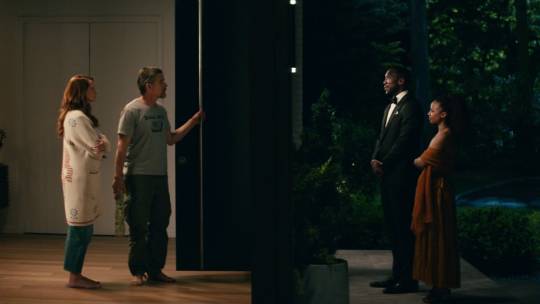
However, the most intriguing and morally ambiguous dilemma involves the unannounced arrival of George and his daughter Ruth (Mahershala Ali and Myha’la Herrold), who claim to be the homeowners. Apparently, they’ve returned seeking shelter due to a blackout in New York City, but whether that’s true is part of the mystery. The characters also happen to be black, a crucial detail for this story and one that challenges both the Sandfords and the audience to confront any prejudices they hold. The more affable Clay is willing to give the benefit of the doubt, but Amanda is skeptical, barely able to conceal her simmering bigotry.
Yet, the characters transcend oversimplified labels; they’re realistic, their behaviour nuanced. The actors involved are too experienced for one-dimensional performances. Indeed, it’s quite rare for such a distinguished cast to be in this kind of project, but it’s a welcome luxury and one that makes up for an underwhelming picture.
The actors hold our attention and pull us into this mayhem, but so too does Esmail, whose keen sense of pacing and dialogue, combined with the performances and Mac Quayle’s eerie score, helps craft a gripping experience, a mystery begging to be unraveled. The setup is akin to Jordan Peele’s Us, 2019’s near-masterpiece that also begins with strangers arriving at the rental home of a vacationing family. Yet, adept as he is, Esmail falls short of Peele’s mastery of ideas and images.

For one thing, he’s overly busy with his camera. It moves around every which way, from above and below, spinning around and spying on our characters. At first, it adds suspense, but it becomes distracting, as if a recent film grad’s just itching to use every trick he’s learned. He also stages some clunky set pieces involving a crashing airplane or a fleet of self-driving cars that deviate from the story’s tone. Even worse is a late scene featuring a sea of deer that’s unintentionally goofy due to some shoddy CGI and bizarre character reactions.
As the larger picture comes into focus, the tension dissipates like the air from a balloon as we reach a conclusion that feels, if not predictable then frustratingly inevitable. Esmail is an astute observer of humanity and the conclusions he draws are sound, but it’s as if he’s reciting an essay instead of telling a story. Much of the content is over-explained, leaving scant room for subtext or interpretation. At the same time, he scatters on the screen an array of societal flaws like class inequality, racism, cynicism, over-reliance on technology, environmental abuse, etc but never completely zooms in for a closer look, settling for superficial insight.
This trend of over-explaining and under-developing is seen in the racial tension that develops subtlety but never fully, and when the filmmakers do address the sad situation of the black homeowners sleeping in the basement while the white visitors sleep upstairs, a character spells it out for us while a visual cue would’ve done just fine. Storytellers like Peele conjure up all sorts of intriguing symbols and concepts that coalesce for the narrative’s sake but not at the expense of our own intellect or imagination. We draw our own conclusions from the exquisite pieces that Peele lays out; in Leave the World Behind, Esmail does all the work for us.

There’s a subplot in the film involving the daughter, Rose (Farrah Mackenzie), and her quest to finish the program, Friends. She’s reached the series finale but can’t stream it once the internet goes down. This is her primary concern as the world’s ending. It’s supposed to be a metaphor for our misplaced priorities and over reliance on modern technology, but it also represents the seemingly trivial little bits of comfort we cling to when we’re distressed. This relates to something Clay says about his student who’s writing a book on how media serves as both an escape and a reflection.
Friends was never extraordinary. It’s not as brilliant, incisive or original as some of its contemporaries like Seinfeld or Frasier. Yet, despite that, its characters and their stories make it thoroughly watchable. In that sense, Leave the World Behind is as much a reflection of Friends as it is the real world, though it’s doubtful you’ll revisit it as much as the juicy drama between Ross and Rachel.
0 notes
Text
Barbie: **** out of 5
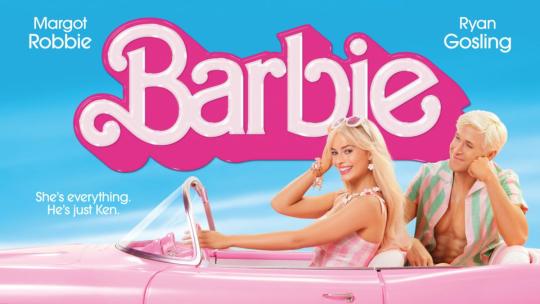
As I was leaving a screening of Barbie amidst a sea of elated fans, I overheard someone saying, “That was so much better than I thought it would be.” Honestly, I didn’t share the sentiment. That’s because I was certain it would be great the second that I learned it was Greta Gerwig’s next project. A wonderful actor and writer, Gerwig eventually directed her first film Lady Bird in 2017 followed by Little Women in 2019, both extraordinary works and two of the best reviewed movies of the last decade. I wasn’t excited for Barbie; I was excited for Gerwig’s third feature.
That feature is half of the ‘Barbenheimer’ cultural phenomenon. Never in a million years would I have pictured Gerwig, the de facto Queen of Indie Films, at the center of two blockbusters vying for box office dominance��in the same week! What’s more, her film is actually winning the financial battle against Oppenheimer, the second film in that portmanteau whose director, Christopher Nolan, churns out blockbusters like Mattel churns out plastic dolls.
One such doll, Barbie, is the star of this film and an American institution launched in 1959 whose instantly recognizable brand floods the hallways of countless stores. Some might view the film as cynical commercialism—this two-hour showcase definitely won’t hurt sales—but, that opinion is reductive. The opening scene alone defies expectations and reminds us of the exceptional talent behind the camera, including co-writer Noah Baumbach, who’s even more ‘indie’ than Gerwig, and both her creative and romantic partner.
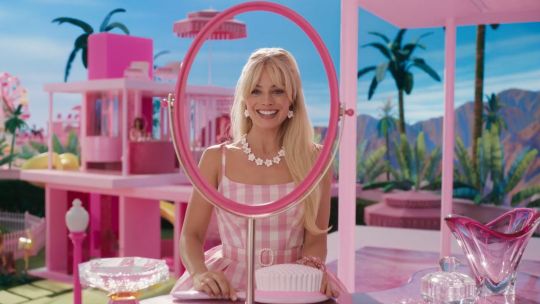
You may not know the people behind the camera, but you do know the star in front of it. Possessing otherworldly beauty (narrator Helen Mirren has a killer line about this) and exceptional acting skills, Margot Robbie’s casting is a no-brainer, which is ironic considering how inclusive the cast is; dozens of Barbies inhabit Barbieland, composed of various races, body types and gender identities. That goes for the Kens as well. But, Robbie plays Stereotypical Barbie, a crucial aspect of the story that the film makers stress often, mainly to highlight a standard that impressionable, vulnerable young people experience so often.
And so, the perfect Barbie played by the perfect actor lives a perfect life in a hot pink utopian society where the Barbies hold all positions of power while the Kens, including Beach Ken (a priceless Ryan Gosling), chill at the beach and try, unsuccessfully, to woo the ladies. The nonchalance of Barbie’s rebuff of Ken speaks volumes about this social hierarchy. Robbie’s Barbie has a daily routine, executed as if a child were controlling her, rituals that include sipping from an empty cup and floating from bedroom to driveway because what child would walk her doll down every stair?
This occurs on a meticulously constructed set, realized by designers Sarah Greenwood and Katie Spencer. Built on a solid foundation of whimsy and charm, this community—whose geographic and temporal relationship with the ‘real world’ wisely is left ambiguous—is the product of stunning practical effects in place of tempting CGI. Like in recent films, interestingly, such as Beau is Afraid and Asteroid City, the set resembles a colourful diorama, at once fantastical and tactile. It’s a world of make-believe you can otherwise almost reach out and touch, just like the toys that inspired it.

But toys don’t have sudden preoccupations with mortality like Barbie does during a dance number, handled with perfect comedic timing by Robbie. She’s also horrified by newly flat feet and patches of cellulite. It’s around this point when the story shows it has more on its mind than just brand promotion. That trend continues as Barbie consults Weird Barbie (the delightfully weird Kate McKinnon) who’s an outcast yet the wisest of them all. Lurching about, contorting herself and giving those big-eyed, alien-like looks that McKinnon has mastered, she tells Barbie to find the girl who’s controlling her in the real world.
With Ken stowing away in Barbie’s convertible, the two arrive in Los Angeles’s Venice Beach, enveloped in neon spandex. There’re some standard fish-out-of-water moments played for laughs, sure, but Gerwig and Baumbach also use this framework to explore a myriad of social issues with the same amount of fervor used to entertain. After being ogled relentlessly at the beach, Barbie is cat-called by some construction workers, but that cliché is subverted as Barbie simply and unexpectedly explains that she lacks genitalia. It’s brilliant.
As with Gerwig’s previous films, it’s difficult to pin down a specific message; she explores numerous issues and isn’t one to tie things up in a neat little package. The stories have feminist underpinnings, but they’re never reduced to simple dichotomies like ‘women are good/men are evil’. Yes, men are portrayed as misogynists occasionally or embody corporate greed in the case of the idiotic Mattel executives led by a pompous Will Ferrell as the CEO. We also see the dangers of an impressionable air head like Ken learning of the patriarchy and introducing its flaws to Barbieland, hopefully bringing attention to how insufferable bro culture can be. Yet, Gerwig’s brand of feminism is sympathetic to male struggles too, especially toward the end, even if much of their behaviour is rightly judged.
Mattel isn’t even immune from judgment; the writers get away with a surprising amount aimed at the company, specifically regarding their toys’ negative influence on body image and self- esteem. For a film maker to resist the pressures of both studio executives and the heads of the represented brand, especially with the huge stakes of a blockbuster production, is truly remarkable and a testament to the audacity of Gerwig who’s unwilling to sacrifice her artistic integrity. Mattel also deserves some credit for acknowledging their shortcomings and vowing to do better. Everyone wins here.

That includes the audience, most importantly. Not only are we treated to hilarious, candy-coloured entertainment, but we’re given a smart film for adults that kids will also enjoy and whose insight will benefit both. It challenges corporate power, the patriarchy, beauty standards and stereotypes while promoting inclusion, autonomy and self-confidence, mostly in creative and entertaining ways though, occasionally, unlike Gerwig’s previous films, a bit too overtly if not altogether preachy. America Ferrera, with a soulful and honest performance as the Mattel employee Gloria, gives a tirade about society’s ridiculous expectations of women; it’s hard to refute her argument, but the delivery feels too familiar in this otherwise unique experience.
It’s an experience that relies heavily on its two leads, both marvellous. Gosling eschews his usual dead-eyed intensity for a relaxed turn as a lovable nitwit and does so effortlessly (no offence). It’s Robbie’s (Barbie) world, however, and we’re all just accessories. The roll is deceptively complex, requiring an actor with more than just beauty to be at once effervescent and existentially preoccupied. Both her performance and the story are capped off with one final word that recalls a line (also the final one) by Nicole Kidman in Eyes Wide Shut, appropriate considering Barbie begins with an explicit reference to another Stanley Kubrick masterpiece. It’s a word that Robbie announces with aplomb when it would otherwise be whispered with embarrassment; a word she wields like a weapon, charging forward into a new life in the name of unapologetic femininity.
13 notes
·
View notes
Text
Glen Coco’s Top 10 Films of 2022

Hey, look out, gang, movies are back in theaters! Isn’t that exciting?! Get off the couch and go to some, so theaters don’t close! Also, I usually share my top 10 films of the previous year much closer to the Oscars ceremony, but it’s been Procrasti-Nation up in my life and I have a real job. Anyway, introductory paragraphs are so 2008 and I’m already 2000 and late, so I’ll just get on with my top 10 films of 2022...after the runners-up and the standard bonus track...there’s always a bonus track.
RUNNERS-UP
-Everything Everywhere All at Once
-The Fabelmans
-The Northman
-The Whale
-Women Talking
#10b. (Bonus Track) Nope
Director: Jordan Peele
Starring: Daniel Kaluuya, Keke Palmer, Steven Yeun

Like his previous films, Jordan Peele’s third feature begins with an entrancing prologue that begs to be deciphered, especially its relationship to the film as a whole. As the story unfolds, all its seemingly disparate parts coalesce to make a final product that’s a mix of fascinating plot developments, gorgeous photography and insightful themes. Although the payoff this time isn’t quite as satisfying as in his previous works and the themes are somewhat less coherent, Nope is still an engrossing experience, crafted by one of the industry’s most distinct and creative voices. A master of utilizing and manipulating an array of tantalizing images—inflatable tube men, chimpanzees, the sky—Peele has created a spectacle that, in turn, challenges our fascination with the very idea of spectacles, but just like the characters in the film, we too can’t look away.
#10. Thirteen Lives
Director: Ron Howard
Starring: Viggo Mortensen, Colin Farrell, Joel Edgerton

When 12 young players and coach of a Thai soccer team were saved from the flooding Tham Luang cave during a miraculous rescue mission just five years ago, it was obvious someone would adapt this harrowing event into a film. In fact, there have been several adaptations in various forms already, but that doesn’t take away from the sheer intensity and realism director Ron Howard has imbued in his version, so much so that at times it actually feels like a documentary. William Nicholson’s meticulous screenplay focuses in great detail on the myriad of technical issues faced during the grueling mission and huge stars like Viggo Mortensen and Colin Farrell completely disappear beneath their real-life cave diver characters alongside their Thai acting partners for maximum authenticity. Knowing the outcome is insignificant; when you’re watching the divers swim through dangerously narrow passages or finally exhaling as the boys are rescued, it’s as if you’re there, witnessing the ordeal firsthand.
FULL REVIEW
#9. Top Gun: Maverick
Director: Joseph Kosinski
Starring: Tom Cruise, Miles Teller, Jennifer Connelly
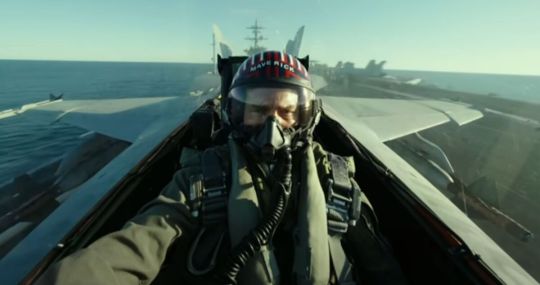
Who knew a Top Gun sequel, released 35 years after the original and unaffiliated with Marvel, Star Wars or James Cameron, would become one of the most successful films of all time? Well, it did and it’s exactly what the dwindling movie theater business needed: an exhilarating combination of eye-popping special effects and nostalgia. Sure, it has some clunky dialogue and cheesy moments here and there, but the mesmerizing flight choreography, numerous callbacks, wonderful acting and a surprising amount of pathos render those flaws trivial. And in these uncertain times, there’s such a strong feeling of comfort and familiarity seeing a true movie star like Tom Cruise flash that iconic smile and save the day. It helps that he gives one of the best performances of his career as the now-veteran Maverick, instructing a new class of pilots which includes his old partner Goose’s son, played with apt restlessness by Miles Teller. Cruise’s talent is most evident in a poignant scene that reunites him with former rival and currently ailing Iceman; in a story set so frequently in the sky, this heartwarming scene grounds it with a level of tenderness that’ll take you by surprise.
#8. Bones and All
Director: Luca Guadagnino
Starring: Taylor Russell, Timothée Chalamet
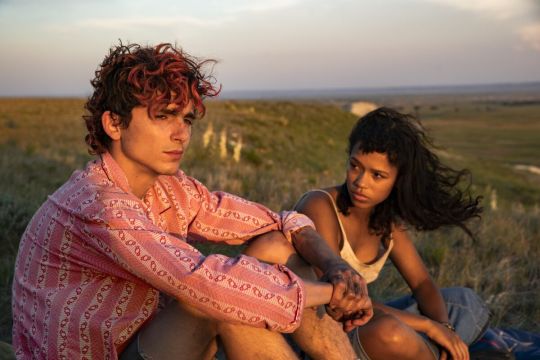
Here’s something you’ve probably never heard: one of the most romantic films of the year follows two young people with an insatiable urge to consume human flesh. Bones and All isn’t some typical zombie or cannibal B-Movie, though; the content is treated with the same sincerity as a great prestige picture. Taylor Russell and Timothée Chalamet don’t play one-dimensional monsters but fully realized outcasts who we come to not only understand but care for, especially as their romance, based on a unique type of belonging, blossoms. Aside from romance, the film’s also a metaphor for drug addiction and the poor souls on the fringes of society. Not exactly a horror film, it still includes graphic, bloody images that are at once shocking and matter-of-fact, not meant to frighten but to bring us into these characters’ bizarre reality. Perhaps the most frightening aspect of the film is a truly creepy character portrayed by the invaluable Mark Rylance, who, in an award-worthy performance, embodies the darkest side of this lifestyle, one unbound by any moral code. Employing fittingly grainy photography, director Luca Guadagnino evokes similar films from the ‘70s and ‘80s, giving atmosphere to one of the most unique movie experiences of 2022.
#7. Marcel the Shell with Shoes On
Director: Dean Fleischer Camp
Starring: Jenny Slate, Dean Fleischer Camp, Isabella Rossellini
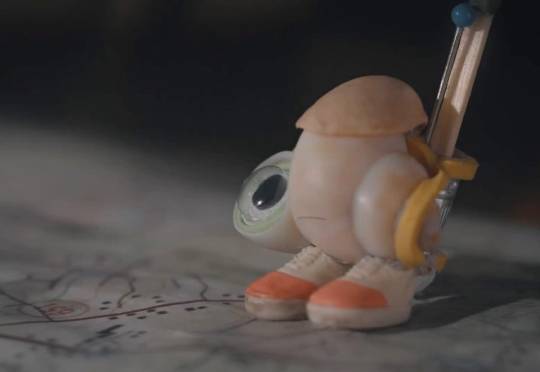
It takes serious discipline to avoid using the word ‘charming’ in every sentence describing this movie, but that’s basically it in a nutshell--or, rather, seashell. Indeed, a seashell is what Marcel is, the protagonist at the heart of this live-action/animated hybrid gem. Based on Dean Fleischer Camp’s animated shorts that gained popularity years ago, this feature is an example of art imitating life in that a fictionalized version of the writer/director moves into an Airbnb, discovers Marcel living there and makes documentaries that go viral. The imagination on display with regard to how the inch-tall Marcel and his grandmother interact with their human surroundings is pure whimsy, whether they’re using wine corks as chairs or a spinning record as a treadmill. Voiced by Jenny Slate with an adorable child-like rasp, Marcel is instantly endearing, as are his drolly nonchalant exchanges with his new human friend. Beyond the film’s overt appeal, there’s also an underlying debate about the pros and cons of social media that adds some weight to this otherwise light and...charming...experience.
FULL REVIEW
#6. Moonage Daydream
Director: Brett Morgen
Starring: David Bowie

If you’re looking for a cinematic Wikipedia entry of David Bowie, this is not the documentary for you. Granted, it would’ve been nice to hear more anecdotes from friends and colleagues, but what we’ve been gifted by Brett Morgen, who wrote, directed, produced and edited the project, is a kaleidoscopic stream of consciousness brought to life. Told roughly in chronological order (emphasis on ‘roughly’), the film shows many of Bowie’s live performances, interviews, film roles, side projects (ie. sculpting, oil painting) and extensive behind-the-scenes footage. Bowie himself provides voice-over work throughout, musing on topics like art, love, religion, identity, life itself and no shortage of philosophy, in place of mere dates and locations. Though several are included, Morgen interestingly omits many of Bowie’s greatest hits, in favour of more obscure songs, and it’s a testament to the genius’s artistry that they’re just as phenomenal. The way Morgen incorporates these songs, how and when he combines them with the wondrous imagery, is sheer poetry, culminating in a jaw-dropping climax. This is how Bowie would’ve wanted his story to be told, a work that can be labeled with the same word used to describe Bowie’s entire life: art.
#5. Bodies Bodies Bodies
Director: Halina Reijn
Starring: Maria Bakalova, Amandla Stenberg, Pete Davidson, Myha’la Herrold, Lee Pace, Rachel Sennott, Chase Sui Wonders
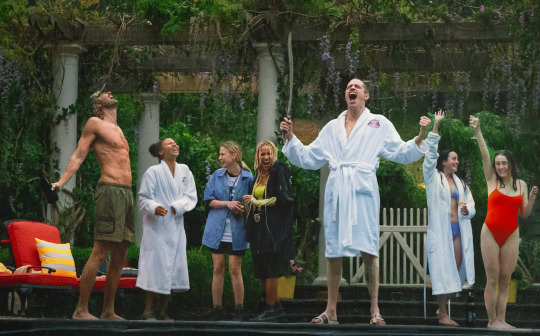
Described as a horror film on Wikipedia and marketed as a slasher flick, Bodies Bodies Bodies is definitely not the former, debatably the latter and, in fact, one of the funniest movies of the year. The black comedy sees a group of mostly wealthy twentysomethings gathered for a ‘hurricane party’ at a mansion owned by the parents of the host. Following a murder mystery game, the partyers start dying off for real, but instead of cooperating to survive, they succumb to pettiness and paranoia, exacerbating the situation in a manner both hilarious and sadly believable. Set in one location, the film relies heavily on its charismatic young cast and a smart screenplay by Sarah DeLappe that’s kinetic, engrossing and astute. It’s also, finally, a delightful skewering of various qualities of Generation Z from constant validation-seeking to endless labels to jobs that may or may not be real jobs. It culminates in a deeply satisfying finale that ties things up perfectly and validates everything that preceded it, an ending that’s at once brutal and entirely cathartic. And even if you don’t love this film, you’ll still love to ‘hate-watch’ it.
#4. All Quiet on the Western Front
Director: Edward Berger
Starring: Felix Kammerer, Albrecht Schuch, Daniel Brühl

It’s fascinating how a movie so enveloped in drab greys and blues and caked in mud could look so striking. That’s the case with the latest adaptation of All Quiet on the Western Front; director Edward Berger and cinematographer James Friend take a dark period in history from which we’re far removed and pull us in with crisp, vivid images. Occasionally, we’re treated to beautiful views of forests and fields, but more often we experience the horror of the battlefield, complete with muddy trenches, severed limbs, pools of blood and incessant fear. It’s a stark contrast to the praise and glory the idealistic young Germans were promised by their overzealous superiors. Felix Kammerer shines as the naive Paul Bäumer, a symbol of the loss of innocence in war, his big bright eyes gazing at the inhumanity before him. These messy scenes are juxtaposed with those featuring Daniel Brühl, a German official trying to negotiate peace with men in spotless uniforms inside ornate rooms. The film’s stellar technical achievements support equally awe-inspiring personal moments as in the film’s most powerful scene involving soldiers on opposite sides of the war when a character ignores his programmed hatred and allows his humanity to take control.
#3. Tár
Director: Todd Field
Starring: Cate Blanchett, Nina Hoss, Noémie Merlant

Written, directed and produced by Todd Field, Tár is a masterclass in nuance and precision. Every frame, every line, every movement is so deliberate and full of meaning. This style perfectly compliments Lydia Tár, the world-famous composer and conductor, played by Cate Blanchett in a pitch-perfect, and perhaps her best, performance. The character’s accomplishments are extraordinary, especially for a woman in that field. It’s hard not to admire this trailblazer, even as her challenging behaviour and potentially problematic actions surface. But, Blanchett and Field refuse to make her simply unlikable or provide tidy labels like ‘villain’. Her subtle actions like gripping someone’s hand to stop incessant pen clicking or employing a slight inflection on a certain word tells us volumes about who she is. As the film proceeds, we learn that she may have a history of sexual misconduct, but we’re provided subtle hints gradually rather than an overt information bludgeoning. Ultimately, the story tackles timely issues like the ‘me too’ movement and cancel culture, but Field shows monumental restraint in refusing to take a side, instead choosing to treat the audience like mature adults and reserving judgment for them.
#2. The Banshees of Inisherin
Director: Martin McDonagh
Starring: Colin Farrell, Brendan Gleeson, Kerry Condon, Barry Keoghan

The Banshees of Inisherin is set in 1923 on a small, sparsely populated island off the coast of Ireland where life is quiet and predictable. Things are rationally organized, from the sharp divide between rocky cliffs and water to the rows of stone that separate fields from foot paths. That’s why it’s so jarring when Colm refuses to join longtime friend Pádraic on their daily trip to the pub because, we soon learn, he just doesn’t like him anymore. A friendship’s decline is a simple premise but one that leads to profound developments as both emotions and stakes intensify rapidly. It’s a fascinating character study, enhanced by magnificent performances from the year’s best acting ensemble. Banshees tells an intimate story, but it reflects the current state of our society at large. The powerlessness felt by some of the characters mirrors what we’re all feeling in a world afflicted by a raging pandemic, a senseless war and an eroding democracy. Because it’s a Martin McDonagh film, the character analysis, dark humour and moments of genuine feeling are blended with the macabre, but take that all away and you still have endless lines of riveting dialogue. That’s one reason why the omission of flashbacks was such an apt decision. We don’t need to see the friendship as it once was; these marvelous actors tell us everything we need to know about a joyful past, a turbulent present and an uncertain future.
FULL REVIEW
#1. EO
Director: Jerzy Skolimowski
Starring: Ettore, Hola, Marietta, Mela, Rocco, Tako (all donkeys)
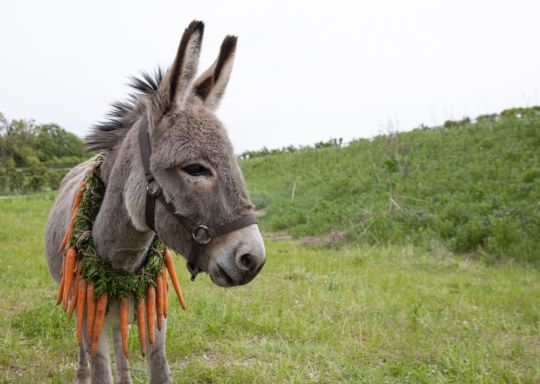
The best film of 2022 features an undeniably charismatic lead. Like many icons of film, this one is beautiful, benevolent, charming, and sympathetic. He also happens to be a donkey named Eo. I was so curious as to how this story would be told since it’s not a documentary about donkeys but a scripted work of fiction starring one. He’s neither animated nor a product of CGI over which the the film makers have complete control. This makes Polish writer/director/producer Jerzy Skolimowski’s deeply moving film EO not only impressive but subversive. In fact, instead of anthropomorphizing the donkey as Hollywood is wont to do, Skolimowski embraces his non-human nature, presenting a real living donkey as the wonderful creature he is.
The story begins with Eo working in a Polish circus with his fellow human performer Kasandra who cares deeply for him until he’s taken away to work at a stable. His journey continues as he moves from place to place, person to person, some kind, some cruel. We see he’s not so different from humans; he enjoys being caressed and loved and protected. He lacks the cruelty, though, which makes caring about him effortless and speaks volumes about humanity. Frankly, few other works will make you reevaluate your feelings toward--and relationship with--animals more than EO, a film that is often as heartbreaking as it is endearing. Yet, it’s not meant to scold its audience or even pass judgement but merely encourage one to view life differently, in this case through the peaceful, unassuming behaviour of a magnificent little donkey.
6 notes
·
View notes
Text
Marcel the Shell with Shoes On: **** out of 5
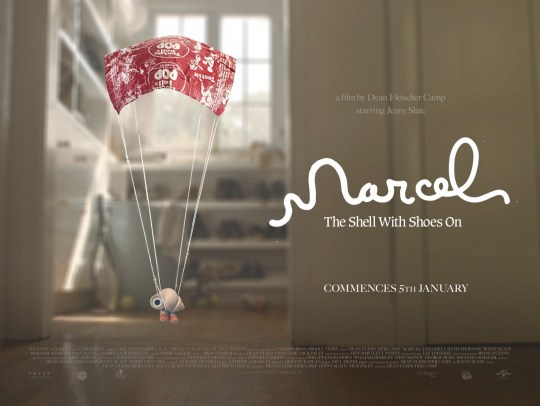
There’s a scene in Marcel the Shell with Shoes On in which Marcel, an anthropomorphic shell voiced by Jenny Slate with a childlike rasp, speaks with a human while his grandmother, Connie (Isabella Rossellini), observes in the background (just go with it). As the conversation continues, we see a laptop off to the side, not the focus but still visible. On its screen, the letter ‘Z’ gradually populates several pages of a word processor. That’s because Connie—bless her heart—is standing on the computer’s ‘Z’ key. It’s this kind of unnecessary but entirely welcome detail that underscores the film’s abundant charm and creativity.
The movie’s framework lends itself to this kind of ingenuity. In his feature debut, writer-director Dean Fleischer Camp has made a film that’s mostly live-action but features several stop-motion animated creations, namely the aforementioned Marcel, an inch-tall talking seashell with a googly eye in his hollow and a pair of snazzy orange and white sneakers. Camp and co-writers Slate and Nick Paley, the former of whom helped Camp write the animated shorts upon which this feature is based, set the film mostly in an Airbnb where they take full advantage of this space and the ways in which tiny non-humans would interact it. Tennis balls are used as conveyances. Wine corks and their wire cages are used as tiny chairs. Bread is used as a mattress…a breadroom if you will. It’s pure whimsy.
A documentarian named Dean, played by Camp, discovers Marcel and company after moving into the house following a divorce. Naturally, he’s fascinated with the little guy; aside from his physiology, Marcel is an intelligent, nurturing and resourceful individual. Assuming he’s as young as he seems, one might call him precocious. He’s also a bit of a paradox, seemingly timid yet prone to disarming bluntness. He’s naïve and lacks knowledge of the outside world, yet he employs idioms and pop culture references. It makes little sense, but it’s undeniably amusing.
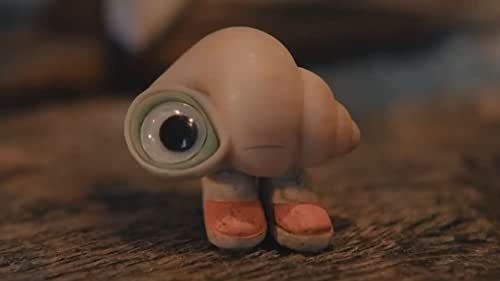
It also explains why Dean starts documenting his new friend’s every-day life, one consisting of mostly gathering resources around the house to improve the lives of him and his grandma who’s so warm and wise but struggling with worsening dementia. Much of what Dean captures involves the garden she tends to and the insects she’s befriended. It’s all so quaint yet with a level of realism that makes it hard to accept these characters aren’t human. That realism also informs the conversations between Dean and Marcel that are drolly nonchalant, as if we were watching college friends work on a screenplay, an effect reminiscent of Cinéma Vérité.
In a case of art imitating life, the footage that Dean uploads to YouTube becomes incredibly popular, a real phenomenon that led to this feature-length adaptation, which in turn led to the footage being uploaded—well you get the idea. It’s very meta. Sadly, our little shell doesn’t quite know how to navigate his abrupt surge in popularity and, to complicate matters, his family isn’t around to share the experience. We learn about an entire community of shells who once lived in the house which included family members, but after the previous owners had a falling-out, one of them accidentally packed up the shells while moving. So, instead of letting fame consume him, he utilizes it to spread word of his missing loved ones.

The word spreads, but Marcel’s fans care more about getting pictures in front of the new star’s home than actually helping him; the increased attention is not only unconducive to Marcel’s plight, but it proves detrimental to Connie’s health. The movie still maintains a light tone, but there’s no question it has more to say about issues beyond talking shells, particularly the value of social media and celebrity. The film doesn’t progress how you might expect, though, as the filmmakers treat its themes with a level of complexity and nuance uncommon in the type of story that would feature a staple of coastal décor as its protagonist.
You can thank the writing and directing for that but also Slate’s excellent voice work. It’s a surprising turn for the actress who’s prone to playing exaggerated characters, yet despite portraying a cartoon in this case, the performance is as grounded as the film itself. She’s especially effective in a quietly powerful sequence in which Dean drives around Los Angeles with Marcel on the car’s dashboard, astonished at how massive the world outside his home truly is and, sadly, how much harder that will make it to find his family.

It doesn’t hurt to have a veteran like Rossellini as a scene partner, one who’s equally dedicated to her unorthodox role, a kind of professionalism that helps the performers find the humanity beneath the characters’ literally hard exteriors. It must be challenging for someone like Camp, playing the main human character, to interact with things that are essentially nonexistent, yet the three actors pull off this magic trick flawlessly.
It took considerable discipline to refrain from using the word ‘charming’ in nearly every sentence of this review, but recycling adjectives is rarely a sign of good writing. Nevertheless, I can’t think of a better word to describe Marcel the Shell with Shoes On. Early in the story we learn that Marcel and Connie share a mutual love of the long-running TV news magazine 60 Minutes as well as one of its presenters, the 81-year-old Lesley Stahl. It takes a truly beautiful—some might say twisted—mind to think of a detail like that. We should be elated they exist.
5 notes
·
View notes
Text
The Banshees of Inisherin: ****1/2 out of 5

On the small, fictional island of Inisherin in 1923, life is simple, quiet and predictable. The Irish Civil War wages on the mainland, but even if the islanders hear occasional gunfire, it might as well be a world away. Inisherin is one of those islands far from the equator that appears at once beautiful and dreary. Sparsely populated by humans—also trees and other landmarks—it’s the kind of place that takes you ten minutes to walk between buildings, even though they’re visible the entire trip.
Moreover, things are organized and rational. Land ceases abruptly as rocky cliffs form a sharp divide from the water below. Rows of piled stone separate the various fields and form foot paths for the citizens and their animals. There’s a stark contrast between the few structures that pepper the island and the land upon which they sit. And in one noteworthy home, there’s a strict rule: the humans may enter; the animals may not (despite how adorable they are).
You can imagine the amount of routine this place cultivates. That’s why the opening sequence of The Banshees of Inisherin is so perplexing, for both the audience and the protagonist, Pádraic Súilleabháin, played by the ever-evolving Colin Farrell. We see him on a walk across the island that he’s taken probably a thousand times, heading to his friend’s house to fetch him for their usual trip to the local pub. That friend is Colm Doherty, played by the great Brendan Gleeson who reunites with Farrell 14 years after their appearance in In Bruges, also written and directed by the master of dark comedy Martin McDonagh. When Pádraic knocks on the door this time, there’s no answer. Colm is there, but he remains seated to the bewilderment of his friend.
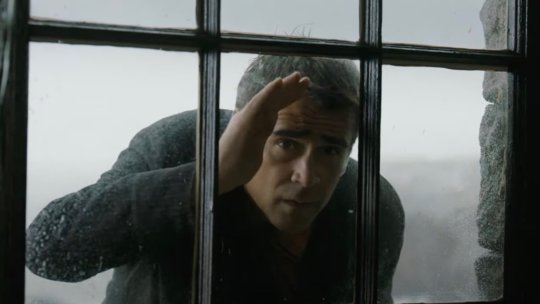
It turns out that Colm doesn’t like him anymore. Thankfully, the reason comes sooner rather than later; that ‘mystery’ isn’t as big of a focus as the marketing suggests. And that’s fine. The quicker the film addresses this, the quicker we can focus on the fascinating character study and themes it underscores, enhanced by engrossing dialogue and magnificent performances.
It's a simple premise, a friendship’s demise, but one that leads to profound developments that snowball quickly as both emotions and stakes intensify. Pádraic is the audience surrogate and in what may be Farrell’s best performance, he expertly conveys the confusion and denial of a seemingly decent man losing control of a once simple life. It’s tragic watching his futile attempts to salvage the friendship with Colm, as if he were those relentless waves crashing into the immoveable stone cliffs. As his emotions evolve into frustration, hopelessness and even rage, we come to appreciate Farrell’s performance even more.
Exacerbating those emotions is a lack of support available to Pádraic. He has a sister Siobhán (an excellent Kerry Condon) with whom he lives in an old stone cottage, amusingly sleeping in different beds in the same room. But, her pleas for Colm to reconsider his stance are fruitless and her familial relationship with Pádraic isn’t an adequate substitute for a best friend. That goes for Dominic Kearney as well, a troubled, young soul played by Barry Keoghan as a tragicomic figure, a yappy fellow you can’t help but pity for his social ineptitude and the abuse endured at the hands of his local policeman father (Gary Lydon). It’s the kind of eccentric role that usually garners an Oscar nomination, an honour that several of these actors might receive.

No doubt, a sense of loneliness fills the air from Pádraic yearning for connection while his friendship crumbles to Siobhán’s simmering restlessness to Dominic’s unrequited feelings for his crush. However, it’s a feeling of powerlessness that’s the most pronounced. We can see it on Farrell’s expressive face as it oscillates between various levels of confusion, sadness and shock, making a tragic situation even more vivid. Conversely, it’s Gleeson’s lack of expression and quiet solemnity in his voice that signals his earnestness.
Banshees tells an intimate story, but it reflects the current state of our society at large. Empathizing with these characters is easy when you’ve felt helpless in a world dictated by a never-ending pandemic, a senseless war and an eroding democracy. It’s the same world that’s seeing intolerance on the rise in many circles, which is why it’s so refreshing to hear characters refer to certain people or actions as ‘not nice’. These lines could be played solely for laughs, but instead of embracing cynicism, McDonagh challenges us to revisit that ‘corny’ idea of kindness.

Because it’s a McDonagh film, the character study, dark humour and moments of genuine feeling are mixed with the macabre. As the feud endures, Colm takes extreme measures to demonstrate his resolve, including severing his own fingers—as one does. It’s a bold narrative choice, one whose omission wouldn’t entirely be missed, but it’s ultimately more harmful to Colm himself than the movie. I’m also on the fence about the local elder Mrs. McCormick (Sheila Flitton) who skulks around the island, warning of doom and gloom like some kind of sinister force, although, I suppose that is on-brand with the film’s darkly comedic tone.
Not to downplay the themes, symbolism and character building, but the film still would’ve been interesting regardless of subject matter. It’s a safe bet that with McDonagh’s writing and these actors delivering the lines, discussions about the most mundane topics would sound utterly riveting. That’s partially why the omission of flashbacks is such a wise decision. We don’t need to see the friendship as it once was; these marvelous actors tell us everything we need to know about a joyful past, a turbulent present and an uncertain future.
5 notes
·
View notes
Text
Thirteen Lives: ***1/2 out of 5

Some news stories are so remarkable, so teeming with drama and intrigue that you just know they’ll inspire a film adaptation. Watching coverage of the Tham Luang cave rescue in the summer of 2018 was like being on the edge of your seat at the movies except the stakes were real and profoundly high. So, naturally, in the four years since that ordeal, there’ve been not only multiple films released but also documentaries, books and song as well.
Even if you remove the variables, it was still a devastating situation; twelve adolescent soccer players and a coach found themselves trapped inside a cave in northern Thailand. What made it uniquely terrifying, though, was that they were about 2.5km from the entrance, trapped there by monsoon rain that continued to flood the cave. These factors combined with the incredibly narrow underwater corridors made the idea of rescue seem impossible. Meanwhile, the team had little to no food, no light, no toilets and no way of knowing if help was on the way. Their fear and discomfort must have been excruciating.
This information makes the opening of director Ron Howard’s Thirteen Lives chilling. The gorgeous green hills that tower over the soccer field where our story begins can only do so much to distract us from the inevitable. Same goes for this joyous scene of a boys’ soccer team wrapping up practise before a birthday party which they were supposed to attend. However, as the youngsters leave the field in excitement, they decide to take a detour to explore a nearby cave and you want to literally shout at the screen, “For the love of God, just go to the party!”

But kids will be kids. There’s a palpable sense of dread when the focus shifts to their parents at the party, especially since we know what their real-life counterparts had to endure. That feeling intensifies as they head to the caves, see the kids’ bikes and fear for the worst. They, along with the audience, realize the boys are in grave danger and need to alert as many emergency crews as possible.
This is inescapably a ‘white saviour’ story in the literal sense that white men helped save Thai children. It’s a controversial trope, but in this case, it’s undeniable reality. It would’ve been irresponsible not to recruit some of the world’s greatest divers based on politics. But, Howard and writer William Nicholson wisely focus on the Thai characters as much as possible: the children, their parents, government officials, journalists, Royal Thai Navy SEALs and so on. In fact, the big Hollywood stars don’t even appear until the second act and even then, they don’t monopolize the story. There’s a true sense of unity here as Europeans and Southeast Asians come together to save lives.
This narrative dispersion is at once a commendable quality and a dramatic impediment. When the British divers Richard Stanton (Viggo Mortensen) and John Volanthen (Colin Farrell) arrive to lend their vast experience and expertise, there’s little fanfare. They don’t march in and take over; the Thai authorities are still running the show. It’s realistic, as is the depiction of these two decent, unassuming men, Richard being slightly blunter and more methodical compared to John’s warm and tactful demeanor. The authenticity is welcome but somewhat hollow and not fully realized. We sometimes struggle to identify with these men—and most of the others—as fidelity takes precedence over character and a concentrated point of view.
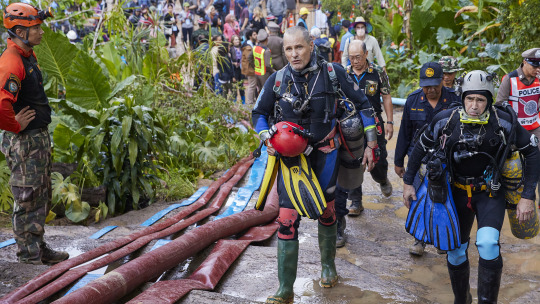
That’s less an overt error by the filmmakers as it is a minor side effect of their discipline and reluctance to ‘Hollywoodize’ a story that’s already brimming with drama. Howard’s more concerned with a meticulous re-enactment and in that sense he succeeds. Obstacles most films would deem inconsequential are treated with a deserved seriousness. The best example is the actual egress of the boys. It wasn’t enough just to find them and guide them out; there’s an enlightening discussion that details the problems that could arise, particularly the panic and unpredictable movement of the boys which would risk both their rescuers’ lives and their own.
That’s where Richard Harris (Joel Edgerton) comes in. Harris is an anesthesiologist who plans to sedate the boys and have them carried out like packages. But, as he explains to the authorities in a pitch perfect scene, if the dosage isn’t precise, it could kill them and with the hours-long dive, they’d need a second dose at some point, administered by mostly amateurs. As he tells them bluntly but with deep compassion, he expects several casualties. Even though we know the outcome, Edgerton’s so convincing, he puts doubt in our minds.

From there, we finally see the long and gruelling rescue. Outside the cave, we witness the politics involved and the brutal decisions faced by governor Narongsak Osatanakorn (Sahajak Boonthanakit). We follow thousands of volunteers including the poor farmers who sacrifice their crops by allowing water to be diverted from the mountains to their fields. Meanwhile, in the caves, Howard and cinematographer Sayombhu Mukdeeprom work wonders with light, space and water to maximize tension. Claustrophobia builds as the divers negotiate dangerously narrow underwater passages with stalactites hanging from the cave ceiling like sharp teeth ready to bite down any second. Periodically, a map appears onscreen showing us how deep inside the cave characters are, just in case we weren’t nervous enough. And the whole time you’re thinking, “How…in the hell…did they pull this off?”
As drama goes, Thirteen Lives has its flaws. You wish for more insight into the minds of the characters, especially the kids who are virtually blank slates. And in its steadfast pursuit of realism, the filmmakers cut some emotional moments a bit too short. But, as a technical feat, it’s mesmerizing. Like the rescue, this is the work of countless dedicated and talented people who’ve recreated an event as accurately and tactfully as possible. Moreover, it’s a testament to what can be accomplished when people from dozens of countries work together instead of succumbing to petty differences.
1 note
·
View note
Text
Thor: Love and Thunder: **1/2 out of 5

Thor: Love and Thunder is a film of many dichotomies…for better or for worse. The most obvious one is right in the title, evoking the contrast between the romantic storyline and the thunderous action. Other one’s include classic ‘good vs evil’ themes and the not-so-classic ‘male Thor and female Thor’ development. There’s even a black and white sequence. Much of this content is quite enjoyable
The same can’t be said about the stark juxtaposition of manic, candy-coated farce that takes up most of the run time and periods of dark, twisted imagery and sorrow that’s sure to cause tonal whiplash. This is one of the many aspects of the film you might find yourself hating, even though there’s still so much to love. And, suddenly, I’m feeling the urge to belt out Katy Perry’s sensational ‘Hot n Cold’.
Of course, Christian Bale can do no wrong, so naturally he’s one of the highlights of the film. He’s a tragic villain, a loving father corrupted and turned sinister and grotesque, not unlike Smeagol in the Middle-earth saga. As Gorr, he struggles to survive in a desert with his daughter, Love, in the film’s prelude. Despite their prayers to the god Rapu, Love dies, and the Necrosword offers itself to Gorr, who not only uses it to kill Rapu but vows to kill all gods with the corrupting weapon. If you didn’t already know, Thor (Chris Hemsworth) is a god, so that means trouble.
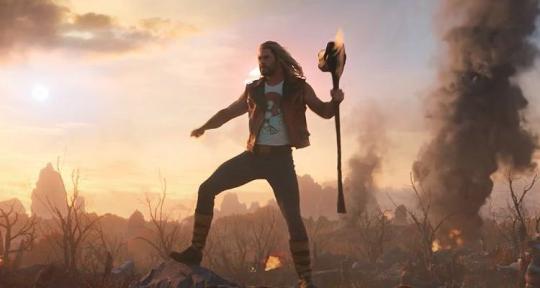
It also means it’s time to catch up with him and his new allies, the Guardians of the Galaxy, who’re battling strange aliens on a strange planet in an obligatory opening action sequence that’s about as obnoxious and pandering as they get in this series. With a scene that features—among several other eyerolling flourishes—Thor doing the splits to hold up two alien vehicles, writer-director Taika Waititi exhibits the worst tendencies of both the Marvel Cinematic Universe and his own films, projects that otherwise have much to offer. It sets the tone for a manically paced film that almost immediately whisks us away yet again once Thor learns of the God Butcher.
We say goodbye to the Guardians but welcome a pair of oversized space goats, the locals’ reward to Thor for helping them fend off their enemy. Throughout the film these goats emit human-like, guttural screams for no apparent reason other than to induce belly laughs from the audience…which they do…several times. I did say there was lots to love about this film.
The bit about Jane Foster’s (Natalie Portman) stage four terminal cancer might’ve been one of those things if it wasn’t bookended so often with goofiness. Not that the MCU is a prime landing spot for heavy material to begin with, but I can think of several entries in the franchise that would be more appropriate than this one. Thankfully, the scenes themselves, isolated from the rest of the film, are quite touching and tactful. Jane refuses to succumb to this tragic fate, however, so she travels to New Asgard, the Asgardian refuge in Norway, hoping that Thor’s fractured hammer Mjolnir will heal her. Forget healing; it transforms her into another Thor, for crying out loud!
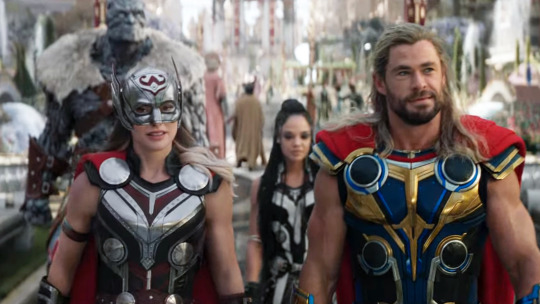
And thank God(s) for that because it’s just in time to help Other Thor, Valkyrie (Tessa Thompson) and Korg (Waititi) defend New Asgard from Gorr in one of several forgettable action sequences. And, so, the film continues from here with the requisite team-up of disparate heroes pursuing the bad guy while engaging in banter that oscillates between amusing and irritating. That’s also an apt description of the love story between the Thors who act like nervous teenagers within a ‘will-they-won’t-they’ dynamic that never quite takes off. As usual, all the characters are still quite likable despite having all gotten oddly dopier between films.
No character is dopier than Zeus, played by an almost unrecognizable Russell Crowe with his unkept beard, doughy physique and exaggerated Greek accent. Crowe plays him as an arrogant blowhard who scoffs at our heroes’ pleas for help as he stands on his podium sporting a golden breastplate that might as well be white cloth with the stench of beer and a mustard stain. Which is ironic considering Omnipotence City, a realm that’s home to several gods of whom Zeus is the leader, is an awe-inspiring paradise among the clouds. Like ancient Greece meets Shangri-La, its cascading greenery, ornamental architecture and otherworldly physics amount to one of the film’s few stunning visuals.

That’s not unlike Bale. One of this generation’s greatest actors throws vanity to the wind as he slithers and stalks and hides in the shadows, his weathered face as pale as the robes that adorn his sinewy body. With a personality that’s by turns aggressive and eerily jocular, he recalls the infamous Pennywise the Clown. In simpler terms, he acts unhinged and resembles the undead. It’s too bad the film makers don’t fully take advantage of his character to really dissect the shortcomings of faith and religion, but that would require the impossible notion of Marvel Studios and Disney alienating much of their fanbase and sacrificing precious revenue. That’s not how you build an empire.
Holding all the pieces of this film together is the narrator, who’s the polar opposite of Gorr. Voiced by Waititi, the unseen storyteller has a gentle, whimsical way with words and tells the story as if it were a children’s fairy tale. It’s a charming touch and describes the events of the film with humour that’s subtle and witty, a reprieve from the comedic bludgeoning you receive throughout most of the film.
Bale’s Gorr and Waititi’s narrator are two of the strongest elements that make up Thor: Love and Thunder. They just don’t belong in the same movie.
2 notes
·
View notes
Text
Glen Coco’s Top 10 Films of 2021

Consistent with the chaotic times in which we find ourselves, the film landscape has become a complete mess. Release dates are tentative, films premier at home the same day as in theaters (or four months later) and the particular streaming service where they arrive is anyone’s guess. But, amidst the logistical tumult, filmmakers continue to craft some great motion pictures. I don’t like preambles as much as I used to, so I’ll just get on with my top 10 films of 2021...after the runners-up and the standard bonus track...there’s always a bonus track.
RUNNERS-UP
-C’mon C’mon
-CODA
-Don’t Look Up
-Licorice Pizza
-A Quiet Place Part II (Full Review)
#10b. (Bonus Track) Nightmare Alley
Director: Guillermo del Toro
Starring: Bradley Cooper, Cate Blanchett, Rooney Mara, Toni Collette, Richard Jenkins, Willem Dafoe
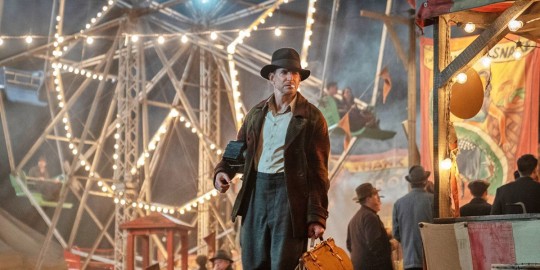
Missing out on the official Top 10 list for departing from the astonishing carnival setting too soon and dragging a bit in the second act, Nightmare Alley still deserves mentioning for its impeccable production design. Even when writer-director Guillermo del Toro’s scripts fall short, he makes up for it with stunning visual storytelling, exemplified here with richly detailed and colourful images of a 1930s carnival, contradicted later in the film by gorgeous art deco designs of city buildings. With a brilliant cast led by Bradley Cooper, del Toro maintains a disturbingly eerie atmosphere throughout despite eschewing his signature fantasy elements, producing a chilling, if imperfect, film noir that takes the viewer through dark corridors (figurative and literal) while examining the worst impulses of human nature.
#10. Tick, Tick... Boom!
Director: Lin-Manuel Miranda
Starring: Andrew Garfield

If conquering Broadway while also acting in and composing music for films wasn’t enough, Lin-Manuel Miranda has now made Tick, Tick... Boom! and you’d never guess it was his directorial debut. The film stars Andrew Garfield as Jonathan Larson, the playwright and composer of the smash hit Rent who sadly died the night before its off-Broadway premier. The film jumps back and forth between 1992, in which Larson performs the titular rock monologue that Miranda uses as a storytelling device, and 1990, in which the exhausted artist prepares for the workshop of his passion project Superbia, works at a diner, tries to maintain a relationship and strives desperately to be successful before turning 30. The movie’s seemingly unending action involving constant movement between time periods and within space, with no shortage of singing and dancing, might feel a tad busy, yet it perfectly captures that relentless creativity, passion and even frustration of the ‘starving artist’. Garfield is nothing if not a passionate performer and he sells every moment of both Larson’s mental anguish as well as elation with every fiber of his being. This is truly a whirlwind of a film.
#9. The Power of the Dog
Director: Jane Campion
Starring: Benedict Cumberbatch, Kirsten Dunst, Jesse Plemons, Kodi Smit-McPhee

The great Jane Campion’s latest film is a western, to be sure, but instead of celebrating the genre’s classic traits, she scrutinizes them while shrewdly subverting the genre in the process. By telling a story about a miserable ranch owner who torments his brother’s new wife and her effeminate son, she critiques the idea of toxic masculinity and its harmful effects on, not just the targets of this behaviour, but the toxic individual himself. This film is a masterclass in subtlety, with a script that reveals its complex characters, their motivations and the various, often shocking, plot developments without spelling it out for the audience. A smart viewer will understand how, for example, a character’s repressed homosexuality can lead to isolation, jealousy, resentment and ultimately the exacerbation of toxic behaviour. This psychological thriller is set amidst Ari Wegner’s gorgeous shots of the New Zealand countryside filling in for 1920s Montana and the brilliant Jonny Greenwood’s appropriately disturbing score that compliments a character dynamic already brimming with tension.
#8. The Last Duel
Director: Ridley Scott
Starring: Matt Damon, Adam Driver, Jodie Comer, Ben Affleck
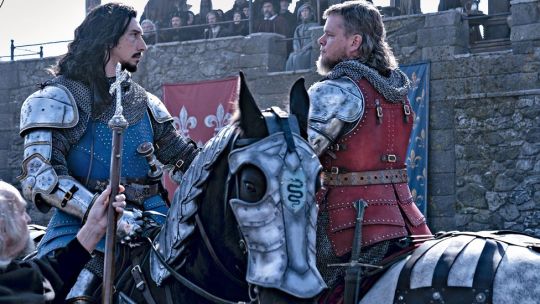
Let’s just get this out of the way: casting famous American actors as French knights using quasi-British accents is an odd choice but nowhere near unprecedented. Yes, it sounds strange at first, but you’ll quickly forget it as you’re swept away in the engrossing social commentary set during the middle ages. Yet, even if this is a time long passed, the themes are sadly still relevant as we’re given three different perspectives of what may or may not be the rape of a young woman. We see some events multiple times, but it never feels monotonous and some parts are different enough that we reevaluate how we feel about the situation and characters, one of whom shifts from a man of honour to a dirt bag right before our eyes. Accents aside, the acting is superb and includes a surprising turn from Affleck who’s a riot as the corrupt and debaucherous Pierre d’Alencon. Ridley Scott’s been inconsistent for a while, but he knows how to put a great historical epic on screen which he does here with grandiose sets and costumes, not to mention the titular last duel forming the film’s climax which is expertly staged and unapologetically brutal.
#7. King Richard
Director: Reinaldo Marcus Green
Starring: Will Smith, Saniyya Sidney, Demi Singleton, Aunjanue Ellis
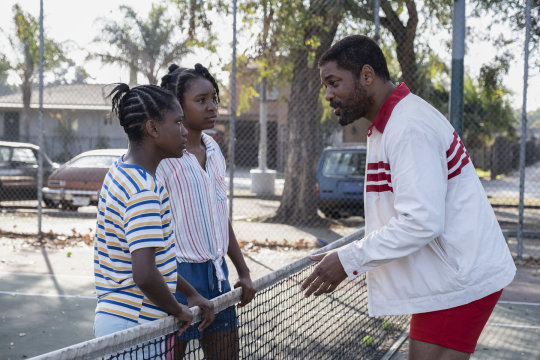
Will Smith has been in so many mediocre films that you might forget he’s a great actor. He gives possibly his best performance to date in King Richard as the father and coach of the young girls who will become two of the greatest tennis players ever: Venus and Serena Williams. With the help of director Reinaldo Marcus Green and writer Zach Baylin, Smith vanishes into this character who he portrays as a complex human being, by turns an honourable, nurturing father and a stubborn, sometimes selfish, old man. But, that’s what elevates what could’ve been a cookie-cutter biopic to an insightful character study and a great example of what a sports movie can achieve with powerful performances, excellent pacing and honest dialogue that doesn’t pander. Some have criticized the film for focusing on the male behind two female athletes’ success, but if it means providing a rare layered and positive portrayal of an African-American father then it’s a sound compromise. That said, the film doesn’t forget about the sisters nor their incredibly supportive mother, all played by excellent actors who make us root for this family whose members consistently excel despite so much working against them.
#6. Spider-Man: No Way Home
Director: Jon Watts
Starring: Tom Holland, Zendaya, Benedict Cumberbatch, Marisa Tomei
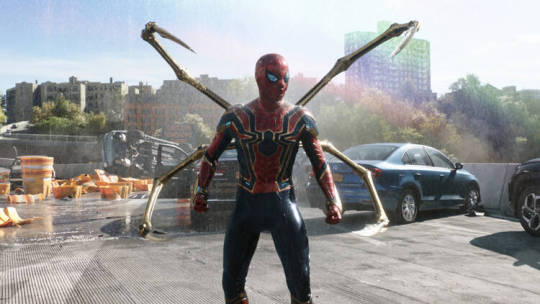
On paper, this film might seem like gimmicky fan service, but to believe that would be to underestimate Marvel Studios. Even if you’re wary of the corporate franchise film model, you have to give credit to this company; No Way Home is the 27th film in the Marvel Cinematic Universe, yet it’s still wildly entertaining, surprising and charming while continuing to connect to the other films in the franchise. Equally impressive is how a movie with so many characters and twists (no spoilers!) can maintain such a high level of coherence and a strong focus on character. In fact, despite all the moving pieces, this is actually one of the more poignant films in the series with huge emotional stakes. Director Jon Watts and writers Chris McKenna and Erik Sommers handle some very emotional scenes with tact, allowing them room to breath and time to sink in. They also show a willingness to take risks, a rare practice in this genre. Altogether, the film offers a perfect opportunity to get cozy, pig out on popcorn and escape reality for a few hours. Lord knows we could all use that!
#5. The Card Counter
Director: Paul Schrader
Starring: Oscar Isaac, Tiffany Haddish, Tye Sheridan, Willem Dafoe

Paul Schrader’s 2018 masterpiece First Reformed was overlooked by both audiences and awards voters and the same is true for The Card Counter. The writer-director excels at telling stories about deeply flawed and tortured men (Robert De Niro in Taxi Driver; Ethan Hawke in First Reformed) and he does so again with the exceptional Oscar Isaac who gives such a measured, disciplined performance, not just at times when he’s quiet and withdrawn but also during intense moments when he becomes a scary force of nature. Due to his controversial military past, a young man seeks his help with a plan to torture and kill a former army major who was known for his horrific interrogation methods. These are shown in flashbacks that feel more like nightmares; we view the acts through ultra-wide ‘fish eye’ lenses and hear pounding heavy metal music. As usual, Schrader peals back the layers of the story gradually and amps up the tension to an almost unbearable level. But, most importantly, he earns our complete investment in Isaac’s character and whether he’ll maintain his current situation as a successful gambler, sparing himself and the boy from a life of violence, or be an accomplice to a brutal act of revenge.
#4. Dune
Director: Denis Villeneuve
Starring: Timothee Chalamet, Rebecca Ferguson, Oscar Isaac, Zendaya, Stellan Skarsgard, Josh Brolin
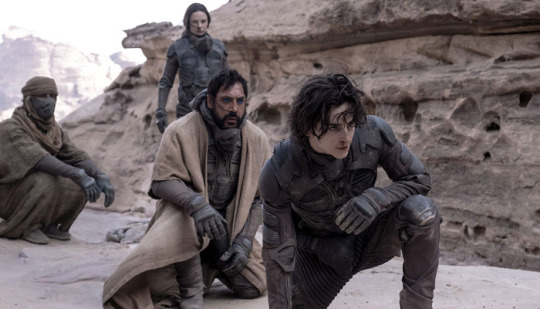
Leave it to Denis Villeneuve, named director of the decade by the Hollywood Critics Association, to take a novel that many have called unfilmable--the awful ‘80s adaptation strengthening that argument--and make his version an aw-inspiring spectacle and indeed one of the best films of 2021. Unlike the original that loses you with a data dump in the first five minutes, the new version introduces you to this world and all its elements gradually and with a variety of strategic methods. It also helps that a handful of some of the greatest actors in Hollywood have assembled to lend their talent and credibility to this project with the prodigious Timothee Chalamet in the lead role. Most impressive, however, are the wondrous visuals; despite working with a seemingly baron dessert setting, Villeneuve brings it to life with gargantuan space ships, labyrinthine structures, giant deadly sand worms and various factions of people with elaborate weapons and armour. Thankfully, the wide shots and lingering camera allow us to marvel at these images instead of taking them for granted. Dune is a prime example of what a blockbuster epic can be when craft and imagination take precedence. *Note: Could’ve used more sand worm.
(Full Review)
#3. The Tragedy of Macbeth
Director: Joel Coen
Starring: Denzel Washington, Frances McDormand
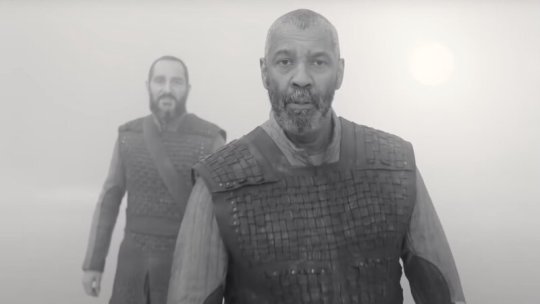
William Shakespeare’s plays have been adapted countless times but rarely are they so striking and brimming with creativity. This is Joel Coen’s first film without his longtime collaborator and brother Ethan and he eschews their trademark dark humour while maintaining his mastery of the craft, making one pitch perfect decision after another. The most obvious one is casting Denzel Washington in the lead role, a subversive choice but the right one. The actor, who the New York Times critics named the best of the 21st century, works his magic, changing convincingly from a loyal and weary soldier to a murderous, power-hungry madman due to the ramblings of three witches and the coaxing of his conniving wife played by the peerless Frances McDormand. Coen shot this gem entirely on a sound stage with the final product at once feeling like a theater production yet utterly cinematic. This is done with the help of cinematographer Bruno Delbonnel, exploiting shadow, fog effects and black & white gloriously, enhancing the story’s suspenseful, occasionally nightmarish atmosphere. These elements combined with very simple yet effective angular stone sets produce a sort of otherworldly feel appropriate for this supernatural tale.
#2. West Side Story
Director: Steven Spielberg
Starring: Ansel Elgort, Rachel Zegler, Ariana DeBose, David Alvarez
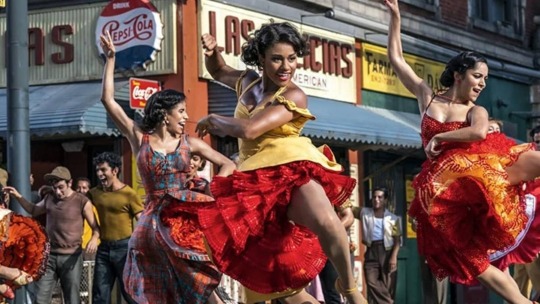
Often when we think of someone like Steven Spielberg, an institution in film for decades, we take them for granted, forgetting how great they really are. I was not excited to see West Side Story, the second film adaptation of the hit Broadway musical. Maybe it’s because I saw another New York-based musical In the Heights earlier in the year or because the film lacks big names or because the idea of dance-fighting confuses me. Whatever the reason, it was quickly forgotten as I was being taken away by the true spectacle that Spielberg put on screen. Believe it or not, this is his first musical, yet he takes an otherwise chaotic series of events and dance numbers and makes it all completely comprehensible. The love story’s charming and the performances are great, but what he does with the routines is pure visual poetry, completely vibrant and full of energy. Even static, dialogue-heavy scenes are filmed with a sharpness that gives the movie a fantastical quality. The film’s highlight is a beautifully choreographed scene set at a dance in a gymnasium, involving virtually the whole cast plus extras. It starts with a continuous steadicam shot that seamlessly transitions to a cable cam shot as the gym doors open that brings us up into the air, providing a birds’ eye view of the the action before plunging us back down into the sea of dancers. It’s a wonder to behold.
#1. Spencer
Director: Pablo Larrain
Starring: Kristen Stewart
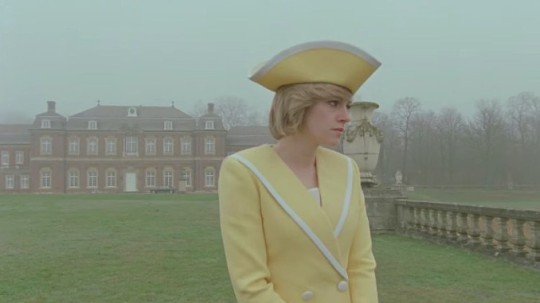
It’s appropriate that the late Princess Diana, née Spencer, is played by Kristen Stewart. Both women are shy, beautiful, talented, anxious, liked by many, ridiculed by many more, in the news for the wrong reasons. But if you’re expecting a standard biopic about this complex figure or stringent historical accuracy, look elsewhere. Pablo Larrain’s transcendent work of mostly fiction is too ambitious, unique and mesmerizing for the typical formulaic, decades-spanning account. Instead, it’s set over three days beginning on Christmas Eve at the Queen’s Sandringham estate during a turbulent point in Diana’s marriage. We’re shown how isolated and anxious she felt at the time, stuck in a remote house with cold, unloving in-laws, her only friend the Royal Dresser, Maggie, played by Sally Hawkins. We’re given an intimate look inside the tortured mind of Diana whose experiences are so surreal at times that it’s hard to discern between hallucination and reality in this psychological thriller that’s arguably a horror story; with the brilliant Jonny Greenwood’s sinister score, it definitely sounds like one. At the center of the horror is Kristen Stewart, giving the best performance of her underrated career, capturing Diana’s distinct mannerisms and vocal traits while easily gaining our sympathy. Perhaps the most satisfying part of the film is its final sequence, a deeply moving denouement that allows Diana to break free and enjoy a sense of liberation, a happy ending gifted to Diana the character but one that Diana the human being sadly never received.
0 notes
Text
Dune: **** out of 5

Years ago, I saw the first film based on Dune, Frank Herbert’s influential and celebrated science fiction novel that spawned several sequels and a variety of adaptations. I recall being impressed by some of the visuals and the ambition of the project. I remember also being completely lost five minutes in following a bombardment of information about the story’s universe, ultimately counting down the minutes until the end of one of the worst-paced films I’ve ever seen.
So, then, why was I so excited about the latest adaptation when David Lynch’s version left me so depleted? The answer is Denis Villeneuve. Sure, the film has one of the greatest casts ever assembled for a blockbuster, but Villeneuve is the main draw. There’s a reason the acclaimed writer/director was named the ‘Filmmaker of the Decade’ (2010s) by the Hollywood Critics Association. Within an eight-year period, the Quebec native made six feature films, none of which were less than outstanding.
With Dune, he enters the 2020s on a strong note with his most ambitious and improbable endeavour yet: successfully adapting a beloved novel that many have called ‘unfilmable’. It makes sense that Villeneuve would tackle a project on this scale considering the trajectory of his career which began with small Canadian productions, continued with medium-sized American thrillers, and has led him to massive sci-fi spectacles. Yet, he’s always maintained his integrity; he applies the same skill and attention to a film like Blade Runner 2049 as he did to Prisoners or Sicario.
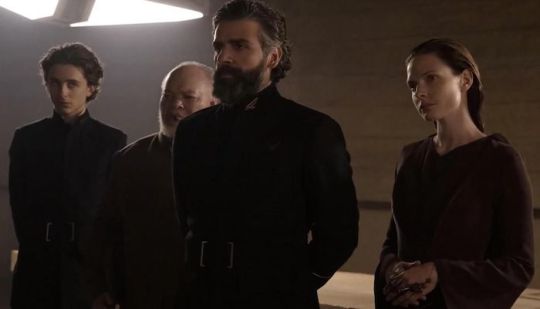
Or Dune for that matter. There’s a tendency for filmmakers to get carried away with movies of this magnitude. Villeneuve presents a grand canvas filled with wonderous images produced by cutting-edge technology, but he eschews the clutter of so many other films in this vein. His effects are used to enrich the setting rather than placate those with small attention spans. He also places his characters at the forefront, so if we do lose track of all the planets, factions, religions, and titles, at least we can fall back on our investment in some interesting people.
Still, this narrative is much easier to follow than the original film. In place of a long preamble with a talking head laying out the rules of Herbert’s universe, we’re given this information more gradually and through various oral and visual means, including audio guides used by Paul Atreides (the wunderkind Timothée Chalamet). You feel like you’re watching a story unfold instead of reading an encyclopedia entry. In any event, it’s a good thing Paul is reading up on the world around him because it’s about to be turned upside-down.
That includes leaving one literal world for another since his father, Leto (Oscar Isaac), Duke of House Atreides and ruler of planet Caladan, is ordered by the emperor to replace House Harkonnen as ruler of the desert planet Arrakis. He sees value in this considering the planet is the only source of spice, an incredibly valuable substance that enhances human vitality and enables interstellar travel. He’d also like to form an alliance with the Freman, the planet’s natives whose ranks include Stilgar and Chani (Javier Bardem and Zendaya respectively). Of course, this transition has a few hiccups; look no further for red flags than Baron Vladimir Harkonnen, the eerily levitating and rotund creeper played by an unrecognizable Stellan Skarsgård.

The story has lots on its mind and amidst all that political intrigue are the crucial religious themes. Such themes are explored through a group known as the Bene Gesserit, a sisterhood composed of those possessing advanced mental and physical abilities. Lady Jessica (Rebecca Ferguson), Leto’s consort and Paul’s mother, is one of their acolytes who trains Paul in its disciplines. The sisterhood, specifically Reverend Mother Gaius Helen Mohiam (Charlotte Rampling), becomes increasingly invested in Paul who’s troubled by visions of the future.
That’s nowhere near an exhaustive list of all the gears in motion, but it does lay the groundwork for the action once House Atreides arrives at Arrakeen, a fortress on Arrakis, action that proceeds more smoothly than in the original. Even Villeneuve is guilty of some pacing issues in previous films, especially Blade Runner 2049; it’s one of that gem’s rare flaws. Here, however, he keeps scenes briefer and dialogue livelier with verbose instances more frequently interspliced with action. The movie’s pacing is better than the meditative Blade Runner and exceedingly more so than the plodding ‘80s Dune.
That’s impressive given the limitations of a desert backdrop. But Villeneuve is a master of visual manipulation, always employing the best camera angles and movement while taking full advantage of the spectacular structures and creatures that pepper this otherwise barren land: the Arrakeen fortress, a brutalist-style structure with its grand halls and sharp angles; the insect-like ornithopters and imposing spice harvesters that blend into their surroundings seamlessly; the underground research station like something out of ancient Egypt; and, of course, the giant sandworms that prowl beneath the vast ocean of sand, making spice-harvesting…onerous.

Possibly the most effective visuals are the perfect cheekbones, piercing eyes and cascading hair of Chalamet who landed this prestigious leading role following a series of impressive performances in smaller films. Take away his talent and still you have his unique visage to observe. This inherent watchability is enhanced by an intensity beyond his years, balanced by instances of playfulness as in his interactions with Duncan Idaho (Jason Momoa), one of Paul’s mentors, House Atreides sword master and owner of the coolest name in the universe. We see Paul jump on this swashbuckler in excitement and who can blame him? The character, like the actor, is just so damn charming.
I haven’t even mentioned Gurney Halleck (Josh Brolin), House Atreides weapons master who acts like a strict father to Paul, counterbalancing Duncan’s role as the jovial big brother. There’s also Glossu Rabban (Dave Bautista), Baron Harkonnen’s hulking nephew, and Dr. Liet Kynes (Sharon Duncan-Brewster), the Imperial ecologist who’s an assertive wealth of knowledge. The movie’s full of so many big stars playing so many characters involved in so much activity that we lose track of our protagonist from time to time.
We’re then left to wonder where that attention was focused. This is a story that feels at once overly busy and strangely uneventful, a peculiar dynamic due partially, perhaps, to its recounting of only half of the first novel. Thankfully, there’s so much to admire about the technical achievements—from the gorgeous visuals to the wonderful acting to Hans Zimmer’s epic score—that you’ll excuse the filmmakers for leaving you less than completely fulfilled, even as you’re eagerly awaiting the next chapter of the story (and hopefully more sandworms).
2 notes
·
View notes
Text
A Quiet Place Part II: ***1/2 out of 5
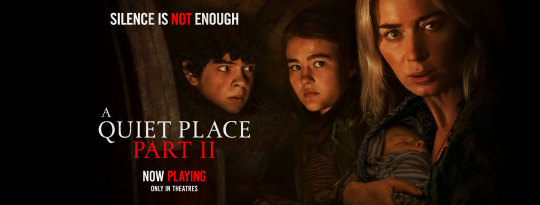
When A Quiet Place premiered in 2018, it surprised viewers in two notable ways: we learned the co-star of a hit sitcom had the capacity to write and direct a great horror film and that this horror film actually had a lot to say, even though its characters could say little. More accurately, they were forced to say little lest the sound of their voices attract the disturbingly angular and unrelenting alien creatures that had no qualms about shutting them up…permanently. It was the perfect metaphor for an American presidency whose ‘leader’ wanted nothing more than to silence and persecute his detractors, something at which he was far less successful than history’s other monstrous dictators.
Following several delays this post-apocalyptic sequel had to endure due to a very real pandemic still going strong, A Quiet Place Part II is finally—thankfully—available for viewing and is once again written and directed by the dynamic John Krasinski, formerly the mild-mannered and loveable prankster from The Office. The first surprise from the original film remains true and therefore no longer surprising; Krasinski continues to be an exceptional filmmaker. Even his fine acting skills are on display again in a flashback sequence. It’s technical achievements like these that more than make up for a sequel that struggles to find something more to say.
We’re treated to a drastically different opening, however. In contrast to the first movie’s preamble which was shrouded in fear and silence, Part II begins on a lively note with a flashback full of smiles, laughter and a little league game, a scene whose real-world equivalent would be referred to as ‘pre-Covid.’ And, although the original prologue ends with a brief burst of action, Krasinski transforms this idyllic picture of the American Dream into a chaotic action sequence with the small-town citizens running for their lives from aliens that have just crash landed on Earth. We’ve already seen these creatures at work, so it’s okay that a gradual reveal is replaced by all out mayhem, a change of pace that’s appropriately jolting without being gratuitous.

Following this revealing glimpse into the past, we’re back in the present where the story picks up right where the first one left off. After realizing they need to, in fact, make loud noise to defeat the monsters—and, in the process, demonstrating how to resist autocrats—the Abbott family emerges from their basement, equipped with the tools needed to survive their brutal surroundings. They’re also carrying a substantial amount of grief as their father, Lee, sacrificed himself to save them just minutes ago. But, if you’re wary about Krasinski’s absence, know that you’re in good hands with the remaining cast in their quest to find other survivors and spread their newfound knowledge.
We all know Emily Blunt is spectacular and deserved Oscar consideration for playing the matriarch Evelyn in the first film. Surprise, she’s still fantastic, but it’s the children who take center stage this time around because, let’s face it, if you want to get a message out today, you need a younger generation. That generation is represented by Millicent Simmonds who reprises her role as Evelyn’s daughter Regan. Simmonds is nothing short of a revelation. Deaf in real life as well as in the franchise, the 18-year-old proves you don’t need to speak to emote like a master thespian or be as interesting and capable as any of the great horror film heroes from Sigourney Weaver to Jamie Lee Curtis.
The even younger Noah Jupe, as her brother Marcus, is also invaluable, though not at the level of Simmonds when it comes to the more nuanced aspects of their craft. He has no problem with raw emotion, however; there’s a scene in which he gets severely injured, crying out in pain, and it’s so believable and intense as to be almost unbearable to watch. Quite simply, your heart breaks for the poor boy.
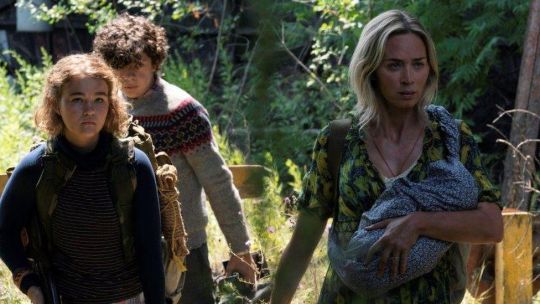
The concept of these films is what attracts moviegoers, but it’s the empathy we feel, so easily instilled in us by the cast and crew, which holds our attention. Countless horror stories fail because we really don’t care if someone dies. In A Quiet Place, not only do the complex individuals elicit our sympathy but the family as whole does as well. Their tight bonds and collective struggle pull you into their reality, making you feel like you’re part of the family.
Krasinski’s direction and Polly Morgan’s cinematography pull us in too. Their camera movement and scene composition are proof enough that this horror film is on another level. The duo has a shrewd way of keeping the camera moving when it might’ve otherwise been stationary or lingering on items of interest at the perfect time, techniques that aren’t simply examples of interesting filmmaking but ones that amplify suspense. Sometimes you wish they’d apply more techniques like these instead of the cheaper jump scares which should’ve been scaled down from the first film instead of highlighted. That’s old news.

So, then, what’s new? Well, certainly the world is richer and more expansive. There’s a new major character played by the enigmatic Cillian Murphy who replaces Krasinski as both a father figure and someone whose big, bright eyes tell a story all on their own. There’s also more ground covered as the Abbotts depart the confines of their farmhouse and even encounter new groups of survivors, some more friendly than others. The expansion of the setting is a natural progression for the series and quite a welcome one.
It’s also natural for the Abbotts to want to share the means to defeat the enemy with other survivors and take back their world in the process. This journey does culminate in a logical conclusion but one that feels a bit like a retread of the original, leaving you wondering if more could’ve been said. Yet, it’s impossible to ignore the film’s marvelous execution and technical achievements. Forgive the cliché, but sometimes it’s not what you say but how you say it.
4 notes
·
View notes
Text
Glen Coco’s Top 10 Films of 2020
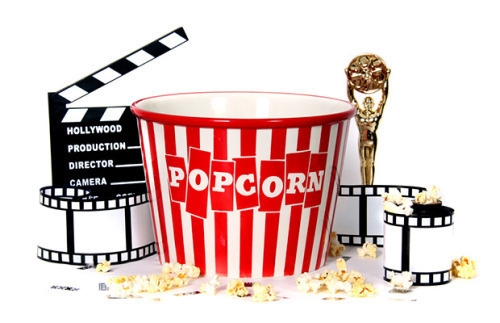
This has been the weirdest damn year for film--and basically everything else--we’ve ever witnessed. Theatres closed, re-opened, then closed again; dozens of films were postponed, and no one knew where to watch the ones that weren’t. I didn’t see nearly as many films as I usually do and, even so, the selection was relatively underwhelming. Nevertheless, there were still some good pictures released, so, as always, I’m sharing my top ten films of 2020 plus a bonus track...there’s always a bonus track.
#10b. (Bonus Track) Borat Subsequent Moviefilm: Delivery of Prodigious Bribe to American Regime for Make Benefit Once Glorious Nation of Kazakhstan
Director: Jason Woliner
Starring: Sacha Baron Cohen, Maria Bakalova

On the surface, Sacha Baron Cohen’s characters may seem utterly absurd and childish--and maybe they are--but, the genius behind them is their ability to reveal the ignorance of the people he encounters and make you question where the true absurdity lies. Cohen accomplishes this yet again, even if this sequel isn’t quite as fresh as its 2006 predecessor. Yet, in the United States of 2020, ravaged as much by asinine politicians, disgraceful racism and dangerous conspiracy theories as by the actual Covid pandemic, Borat is an entirely welcome presence. He makes all the right people look as wrong as they should, especially former New York mayor Rudy Giuliani who’s caught red-handed in a compromising position opposite a very young girl, thus exacerbating his epic fall from grace while reaffirming Cohen’s brilliance.
#10. Ma Rainey’s Black Bottom
Director: George C. Wolfe
Starring: Viola Davis, Chadwick Boseman
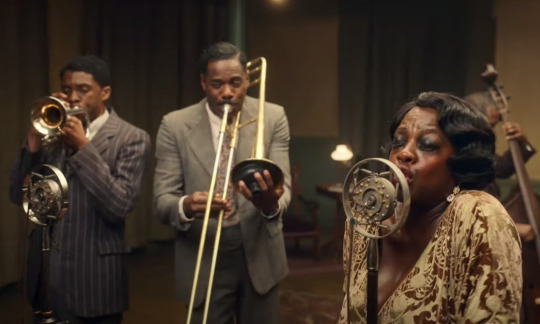
Despite my initial ambivalence, this movie has lingered in my mind for months and that’s always a good sign. Set almost entirely in one location, a 1920s Chicago recording studio, and focusing heavily on a group of musicians shooting the breeze in its basement while their demanding singer talks business with the big wigs upstairs, seemingly nothing much happens and, yet, everything happens; dreams are envisioned, pain is recalled, ideas are shared and, of course, music is made. Those elements are enhanced by the film’s stellar technical features from the production design, to the costumes to the hair & makeup. Yet, it’s the performers who steal the show, which is expected from Viola Davis but a pleasant surprise from Chadwick Boseman who, sadly, gives his final performance. The late actor saved his best for last playing a young trumpeter whose ambitions are constantly hindered by his inability to let go of his tragic past.
#9. The Way Back
Director: Gavin O’Connor
Starring: Ben Affleck

For those of you with the misconception that Ben Affleck is a bad actor, you might want to watch The Way Back in which he plays a former high school basketball star and current alcoholic who’s dealing with the death of his child and separation from his wife when he’s asked to coach his former team. Sure, this covers familiar ground, but it does so better than similar films, finessing the more predictable aspects, adding some welcome touches and treating the subject matter with the respect and seriousness it deserves. The basketball takes a backseat to the character drama here, so the film’s quality relies heavily on the performance of Affleck which might be his best to date; he makes his character’s inebriation so convincing you can practically smell the beer on his breath. And you hope to God he gets the help he so desperately needs.
Full Review: https://thefilmsnob.tumblr.com/post/613090953214001152/the-way-back-12-out-of-5
#8. News of the World
Director: Paul Greengrass
Starring: Tom Hanks, Helena Zengel

This is a film we need right now for several reasons, not least of which being we get to spend two hours with ‘America’s Dad’ Tom Hanks, a decent, honourable man playing another decent, honourable man in 1870 who encounters a strange young girl on the road near an overturned wagon and promises to return her to her remaining family. With Hanks’s character Jefferson Kidd traveling from town to town reading the newspaper for its citizens, this is also a timely film, stressing the importance of a free and fair press as opposed to the propaganda that saturated the Trump administration and his favourite news outlet. An unusually--yet refreshingly--straightforward and old-fashioned Western for 2020, its highlights include a climactic exchange between adult and child, made so effectively tender with such minimal effort by Hanks, as well as a meticulously crafted chase and shootout sequence at the halfway point, directed with optimal tension and clarity by the great Paul Greengrass.
#7. Nomadland
Director: Chloe Zhao
Starring: Frances McDormand
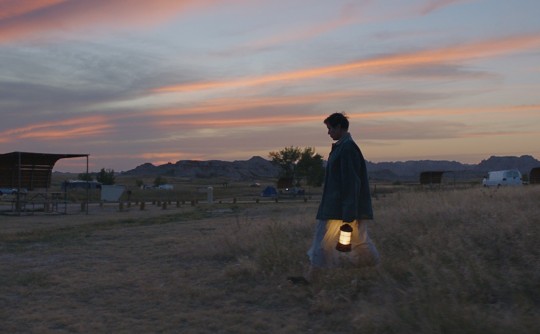
It’s about time we start including Frances McDormand in lists of greatest actors. In Nomadland, in which she plays a wanderer of sorts who’s lost her husband to cancer and her company town to a poor economy, her performance transcends labels like ‘realistic’ or ‘natural’ and arrives at a place that doesn’t feel like performance at all. She blends in seamlessly with a cast of real nomads playing themselves, living out of vans in the western US, as unconstrained by societal norms as the film itself is by conventional story arcs. We want to see this minimalist lifestyle, which includes seasonal Amazon warehouse gigs and long nights in a freezing cold van, as depressing or unfulfilling, but writer/director/producer/editor (Jesus!) Chloe Zhao dares us to admire both the freedom and sense of community formed among this nomadic subculture. Cinematographer Joshua James Richards also plays with our expectations, bathing the screen in soothing blues and purples, transforming the unremarkable landscape into a thing of beauty.
#6. Da 5 Bloods
Director: Spike Lee
Starring: Delroy Lindo, Clarke Peters, Isiah Whitlock Jr., Norm Lewis
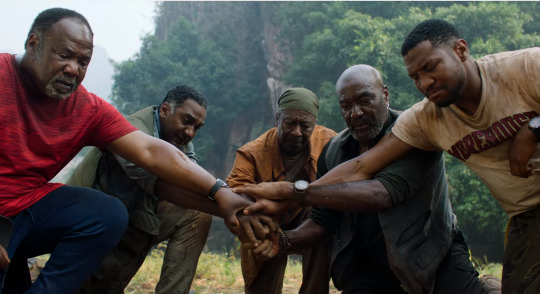
In Da 5 Bloods, writer/director Spike Lee deviates from his usual urban American setting to explore the tropical forests of Vietnam, but his focus remains fixed on the African American experience, their plight and search for justice. His subjects are a group of Vietnam War vets who reunite in present day Ho Chin Minh City to retrieve a cache of gold bars left behind some 50 years prior, originally part of a political transaction, as we see in appropriately grainy 4:3 full screen flashbacks. The reason for this mission is more righteous than a simple payday, but Lee refuses to paint these complex characters with the same brush--there’s even a MAGA in the bunch!--nor does he oversimplify the film’s profound issues. A genre-defying work, Da 5 Bloods is a character study, social commentary, war picture and action/adventure flick all rolled into one with some truly shocking developments and one of the finest casts of the year. How Delroy Lindo was denied an Oscar nomination for his volatile performance is beyond me.
#5. Promising Young Woman
Director: Emerald Fennell
Starring: Carey Mulligan, Bo Burnham, Alison Brie

In one of the most unique films of the year, Carey Mulligan delivers a brave, bold and beautiful performance as Cassie, a woman with a tragic past who spends her weekends at the club pretending to be blackout drunk, only to shame and humiliate the sleazy men who try to take advantage. Writer/director Emerald Fennell does a masterful job at peeling back the layers of this dark revenge tale ever so gradually to reveal Cassie’s true motives while rebuking, not just society’s abhorrent offenders, but those enablers and silent bystanders who try to hide behind a flimsy shroud of innocence. Benefiting from one of the sharpest screenplays of the year and a fitting score, Promising Young Woman never ceases to ramp up the tension, a strategy that culminates in a shocking final sequence which is at once disturbing and satisfying. It’ll all leave you guessing until the final, brilliant shot.
#4. The Invisible Man
Director: Leigh Whannell
Starring: Elisabeth Moss, Aldis Hodge, Storm Reid

Originally conceived as part of the ill-fated ‘Dark Universe’--Universal Pictures’ planned movie franchise featuring its classic monsters--and starring Johnny Depp, The Invisible Man was drastically retooled and produced as a stand-alone film with a modernized story. And like so many horror projects of the last decade, it’s refreshingly inspired and well-crafted with a deeper purpose than merely spooking its audience, though it succeeds at that as well. Writer/director Leigh Whannell uses this movie and the fearless performance of the great Elisabeth Moss to examine abusive partners and their persistent hold on their lovers-turned-victims long after the relationship has collapsed. Moss is stunning as usual, portraying an already traumatized woman trying desperately to convince everyone she’s not going crazy as well, even though that’s exactly how it looks. Equally impressive is the restraint by the filmmakers who use the ‘invisible’ effects sparingly yet strategically, creatively and, ultimately, very effectively, making every scare plausible and entirely earned.
#3. Sound of Metal
Director: Darius Marder
Starring: Riz Ahmed, Olivia Cooke, Paul Raci
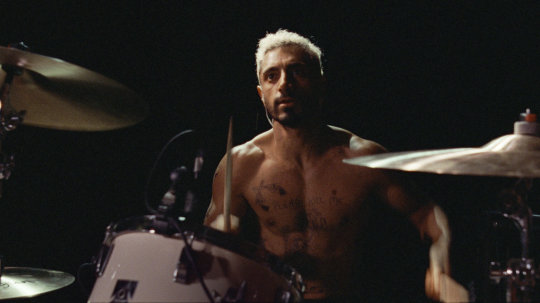
In a world in which people are complaining about losing their freedom because they have to wear a simple mask to save lives, it’s good to see a film that shows what real loss looks like. If you can’t imagine being a heavy metal drummer who suddenly goes deaf, writer/director Darius Marder spells it out for you in big, bold, sorrow-inducing letters. He’s aided by Riz Ahmed giving possibly the best performance of the year as a man who, on the surface, tries desperately to hold on to his life and passion while, deep down, he knows that’s impossible. Sound of Metal is a tender and heartbreaking yet hopeful story, but what’s even more effective than the film’s dramatic presentation is its remarkable sound design. At times, characters sign to each other amidst ambient noise. Other times, the sound is muffled as if we’re putting our ears up to a wall and hearing a fraction of the dialogue from the other side. And, less frequently, when Ruben’s condition is at its worst, we hear nothing at all. Just complete and terrifying silence…which speaks volumes.
Full Review: https://thefilmsnob.tumblr.com/post/647329085467574272/sound-of-metal-out-of-5
#2. The Trial of the Chicago 7
Director: Aaron Sorkin
Starring: Mark Rylance, Eddie Redmayne, Sacha Baron Cohen, Joseph Gordon-Levitt, Yahya Abdul-Mateen II, Jeremy Strong, John Carroll Lynch, Frank Langella, Michael Keaton, etc, etc, etc...
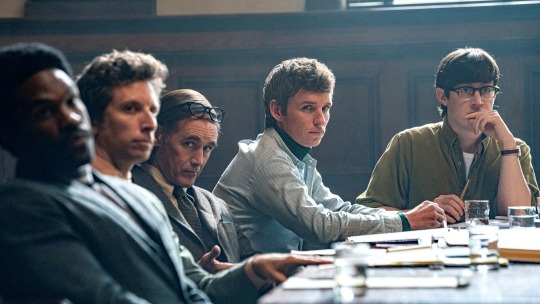
Aaron Sorkin could write about two accountants conducting a routine audit and make it absolutely absorbing. So, imagine what he does with a courtroom drama about the volatile situation surrounding the 1968 Democratic National Convention and the group of anti-Vietnam War protestors accused of inciting riots at the event. Now an accomplished director too, Sorkin organizes all the moving pieces involved with style and grace while deploying his famously kinetic dialogue. With those lines coming from the mouths of his stellar cast, it’s hard not to hang on their every word and be invested completely in their struggle. I could listen to Mark Rylance’s showstopping line-reading of the simple phrase, “No, he doesn’t!”, all day and never get tired of it. Among its many achievements, The Trial of the Chicago 7 deftly navigates heavy topics like police brutality, unpopular wars and a corrupt justice system, showing just how little things have changed in the last 50 years.
#1. Palm Springs
Director: Max Barbakow
Starring: Cristin Milioti, Andy Samberg, J.K. Simmons
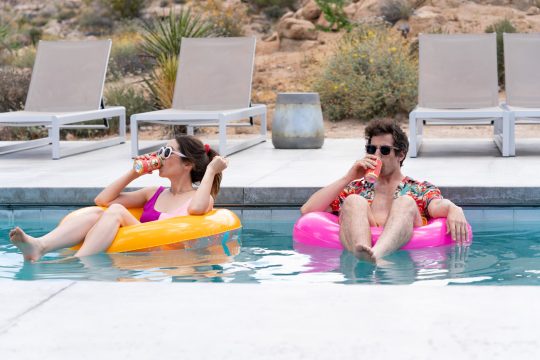
Anyone who knows me may be surprised by this pick, but here we are. Nothing makes sense these days. We’re all as confused and anxious about life as Sarah and Nyles are at a wedding in Palm Springs. Despite what the title suggests, the film doesn’t follow a group of horny teens getting up to shenanigans in the famous resort town, but if I describe the actual plot in depth, I may spoil the fun. I will say these characters seem to be reliving the same events over and over again. What’s so impressive about this film is that, although it repeats itself, it never feels repetitive. The twists and turns, the absurd hilarity blended with bracing poignancy, ensure our unwavering focus on this briskly paced little gem. Yet, it’s the irresistible chemistry between the two leads, played by the equally irresistible Cristin Milioti and Andy Samberg, that forms the glue that holds it all together, whether they’re pulling off childish pranks, discussing their unusual sex lives or debating the very meaning of life. I’m telling you, this movie has everything: comedy, drama, romance, science-fiction (?!), J.K. Simmons, several weddings, an inflatable pizza slice, dinosaurs, a crossbow and colourful beer cans and summer wear that seem destined to become iconic.
1 note
·
View note
Text
Sound of Metal: **** out of 5

Throughout the COVID-19 pandemic—a catastrophic event that most people would agree is real—there’s been an overwhelming amount of loss among the almost 8 billion souls on our planet. People have lost jobs, homes, businesses, friends, health…and even their lives. Some claim they’ve lost their freedom, simply because they’re told to wear a piece of cloth over their face. Sound of Metal, directed and co-written by Darius Marder in his feature debut, is not just a timely film, then, but also a reminder to those in that ‘freedom’ camp of what loss really looks like or, more accurately, sounds like.
Marder wrote the film with his brother Abraham and filmmaker Derek Cianfrance and if you’re familiar with the latter’s previous work like The Place Beyond the Pines and the HBO mini-series I Know This Much Is True then you know that you’re in for a heavy experience. In no way should that dissuade you as a viewer; like those other projects, Sound of Metal is imbued with the same uncompromising reality it deserves. It’s not easy watching Ruben Stone (Riz Ahmed) hit rock bottom, nor should it be.
Ruben is a heavy metal drummer and if you know your films-about-musicians you’d probably suspect ‘rock bottom’ means drug addiction. Sure, that factors into the equation, but addiction is part of the character’s past, albeit a looming part with the potential to exacerbate the problem at the forefront. The good news is he’s four-years sober, but he’s now suffering from hearing loss, an affliction even more devastating to a musician for obvious reasons; not only does his job and passion aggravate his condition, but it would seem almost impossible for someone to create music without the ability to hear it.

When the film starts, Rubin is performing said music, bashing on drums as sweat drips down his bare, sinewy torso peppered with tattoos, his bleached hair glowing in the dark, grungy venue almost as much as his radiant eyes. He accompanies Lou, his girlfriend and singer of their heavy metal duo Blackgammon, played by the incredibly natural Olivia Cooke. In a showbusiness life devoid of glamour, the pair live in an RV and use it to travel from one gig to another across the more derelict corners of the United States. The bleak surroundings and grainy, home-video aesthetic evoke 2008’s heartbreaking The Wrestler, another film that examines the hazards of showbusiness and the grueling process of adapting to life away from it.
After some appropriately raw performances to set the scene followed by shots of the pair meeting their fans and hanging out near the merch table, the film makers get to the meat of the matter briskly. Ruben’s hearing condition flares up early in the story and soon he’s storming out of a live show to have a minor panic attack in a back alley with Ahmed delivering a brilliant piece of acting, instantly convincing us of the horror he’s experiencing. This feeling continues in a quieter yet equally devastating scene in which a doctor explains his hearing test results and the severity of his situation; the doctor gets it, the audience gets it, and deep-down Ruben gets it too, but on the surface the young man is fruitlessly grasping for any easy solution to a complex problem. This extraordinary mixture of desperation and denial is a major component in Ahmed’s award-worthy performance (the eight months he spent learning sign language, taking drum lessons, working with a personal trainer and perfecting his craft with his acting coach should be enough to get him an award).
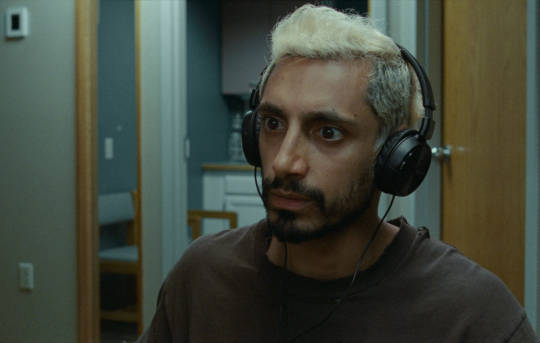
As you’d expect, Ruben continues drumming, ignoring the doctor’s advice to avoid loud noises, but his effort is short-lived. In a dramatic sense, it’s a bit too short-lived. It could’ve been fascinating to see Ruben experiment with different techniques to make and perform music with his disability. It seems like a missed opportunity when you combine that struggle with the inevitable conflicts with Lou that would arise, but Lou does the responsible thing by putting an end to the music and bringing him to a rural shelter for deaf recovering addicts. What a buzzkill. But, ignoring the ‘could’ves’ and ‘should’ves’, the story is still engrossing as we follow Ruben’s journey into the unknown.
Ahmed’s performance certainly makes up for some minor flaws, but the film also benefits immensely from Paul Raci. He plays Joe, the head of the shelter and a recovering alcoholic who lost his hearing in the Vietnam War. Raci is such a natural presence, and he combines vocal acting with sign language flawlessly. Joe is obviously a caring person but provides the tough love that Ruben doesn’t know he needs. He’s the guy who’s been around the block and seen it all; these traits contradict Ruben’s inexperience nicely and make for a fascinating dynamic.

What’s most fascinating about the film, though, is the sound design thanks to Nicolas Becker and company. They put us right in the mind of Ruben and force us to share his experiences. At times, we just see characters sign to each other amidst ambient noise. Other times, the sound is muffled as if we’re putting our ears up to a wall and only hearing a fraction of what’s being said. And, less frequently, when Ruben’s hearing is at its worst, we hear nothing at all, not even the birds chirping or the wind blowing. Admittedly, this makes for a frustrating viewing experience at times, especially when a glitchy hearing aid is in use, but, then again, that’s kind of the point.
Ruben, like many in the deaf community, goes through a very traumatic and life-altering experience and the filmmakers succeed at giving us an accurate glimpse into that life and the struggles that come with it. This is a touching film and your heart breaks for the main character, but it never relies on schmaltz or treats the characters like saints, not even someone as righteous as Joe. It respects the characters enough to treat them like real, complex human beings and respects the subject matter enough to avoid sugar-coating it. What we’re left with is a challenging situation treated with honesty and while the truth can be ugly at times, it’s never less than illuminating.
0 notes
Text
Wonder Woman 1984: **1/2 out of 5

Oddly enough, Wonder Woman 1984, one of 2020’s few blockbusters, reminded me of a quote from the underrated 2011 film Margin Call. In a scene in which the CEO of an investment firm, played by Jeremy Irons, meets with his top brass during a major crisis, he relays this dubious little nugget of wisdom: “There are three ways to make a living in this business: be first, be smarter, or cheat.”
It seems the third method is being deployed more frequently these days in lieu of its moral alternatives; just look at members of the United States government and nearly everything they’ve done in the last four years. This obsession with getting something for nothing was as insatiable in the 1980s as it is today as the movie implies. So, essentially, it’s a very timely story, a draw for some viewers.
The more obvious draw is that it’s a light and colourful action film, a means to distract us from our current situation. Considering how much acclaim 2017’s Wonder Woman received, it being a rare gem in a sea of mediocrity that is the DC Extended Universe, the sequel had enormous potential from the outset. But, what’s potential without payoff? After all, if writer/director Patty Jenkins and co-writers Geoff Johns and Dave Callaham relied on goodwill and hype over hard work and craft, they’d be betraying the messages from their own film.

We’re spoon-fed such lessons right from the start. In a flashback to the island nation of Themyscira, the homeland of Diana Prince, aka Wonder Woman (Gal Gadot), we see her younger self compete against much older Amazons in an elaborate obstacle course, outperforming them until she encounters a setback and takes a shortcut to make up for it. As she approaches the finish line, her aunt Antiope (Robin Wright) removes her niece from the event, lecturing her about honesty and integrity.
Flashforward to 1984 and Diana’s still living on Earth, working at the Smithsonian in D.C. and fighting crime on the side. She meets the painfully awkward Barbara Ann Minerva (Kristen Wiig, a bold casting choice), the museum’s new geologist and about five other professions that end in ‘-ist’. Like everyone else, she’s saved by Diana who comes to the rescue when Barbara spills her belongings all over the museum floor. They form a friendship which feels awfully nonreciprocal considering Barbara treats Diana like a celebrity of whom she’s incredibly envious. When they’re asked by the FBI to identify stolen antiquities from a robbery, they discover the ‘Dreamstone’ which grants one wish to each holder. The filmmakers go all in with this premise that feels dated and cliché and makes you question if it’s the best they could devise.
There’s also too much attention placed on Maxwell Lord (Pedro Pascal), the stereotypically ruthless businessman whose ambitions far outweigh what he deserves. Hmmm, remind you of anyone? Though he pretends to be savvy and successful, he’s really a failure and seeks the Dreamstone to help save his bankrupt oil company. Pascal’s hammy take on the character with his phony laugh and ear-to-ear smile is amusing at first, but once he gains the wish-granting power of the stone and things escalate to ridiculous levels, he starts to grate on you.

There are many more wishes to go around. After Diana yearns for the love of her life, the late pilot Steve Trevor (Chris Pine, a breath of fresh air), he’s resurrected in another man’s body, though Diana still sees him as Steve. Meanwhile, after revelling in Diana’s confidence, bravery and—well, just look at her—Barbara wishes for and gains these qualities plus Diana’s superpowers. The catch? Their wishes are granted, but they lose something gradually in the process: Diana’s powers, Barbara’s humanity, Maxwell’s health. It’s a constant cycle of wish-making and wish-granting and wish-regretting until the plot gets out of hand and becomes at once too much and not enough.
Why couldn’t we have more of the delightful pairing of Gadot and Pine? Aside from the natural charm and gorgeousness they bring to the table, it’s fun to watch one former fish-out-of-water help the current one navigate a strange, new world that’s radically different from the one in which he died 70 years prior. Obvious crowd-pleasers include Steve trying on various ‘80s-specific outfits or the general lovey-dovey stuff, but the best scene features the pair enjoying some modern art and architecture. Steve approaches a garbage can slowly, admiringly with hands clasped behind his back, right before Diana tells him what he’s actually looking at. His reaction is pitch perfect.

Wiig is great too. That she’s a hilarious entertainer is a given, but she’s a proven dramatic force as well. So, what some might call an odd bit of casting for the supervillain Cheetah, I’d call genius. Her character arc, which takes her from a nerdy rock enthusiast to a confident and lethal femme fatale to a CGI cheetah lady is handled skillfully by Wiig who makes each stage of the metamorphosis convincing. Frankly, she’s even a bit scary in some scenes.
As for the climactic battle, Wiig can’t be blamed for her silly-looking digital costume or the bland choreography. Nor can the other actors for the rest of the uninspired action sequences, though the competition on Themyscira at the start benefits from some creative touches. It’s kind of like watching American Amazon Warrior.
Altogether, Wonder Woman 1984 is a moderately entertaining diversion but a big step down from the original which was, among other things, a refreshing showcase of female empowerment. Too much time is spent on a derivative premise and a generic evil businessman, leaving Wonder Woman to feel sidelined in her own film. And, really, seeing a loud, greedy, manipulative businessman stealing the spotlight from an exceedingly more interesting and competent woman just feels too real right now.
5 notes
·
View notes
Text
Happiest Season: ***1/2 out of 5

If you had to list the movies you’ve seen most in your lifetime, I bet the majority would be Christmas films. Is it because they’re fine works of art? Sure, there’s a few. The more likely reason, though, is that they remind us of simpler times, free from the responsibilities of adulthood. We watch them year after year to hold on to that piece of our childhood we miss so much, knowing even the worst ones can fill us with Christmas cheer. There’s a reason why Hallmark movies have become so damn popular and it ain’t the striking cinematography.
Happiest Season, the latest holiday helping, written and directed by Clea DuVall and co-written by Mary Holland, has better cinematography for sure. Not surprisingly, it has better lots of things, a luxury that a feature film production can afford. Yet, the standard holiday tropes are still present: a large family gathering, at least one romance, a shopping mall scene and even the oddly pervasive slapstick episodes (a certain one involving Peter Dinklage makes me cringe every time I watch Elf, an otherwise splendid film).
Within that framework, however, is a feature that few families have seen while cozying up on the sofa in front of the television, hot chocolate in hand with the fireplace crackling in the background. It has a lesbian couple. In fact, there are several gay characters. And, hallelujah, is it ever refreshing, especially in a year punctuated by so much divisiveness. Sure, there are many films with gay characters, but to release one during a season that showcases what many conservatives see as sacred ‘traditional family values’ seems like a bold move.
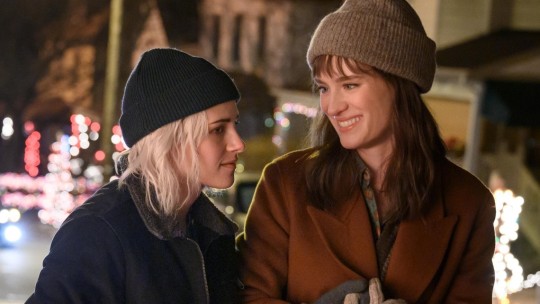
The love birds in question are Abby Holland (Kristen Stewart) and Harper Caldwell (Mackenzie Davis) and the casting for these marginalized women is fitting since Stewart is grossly underappreciated and Davis is tragically underutilized. Harper is trying to get Abby into the Christmas spirit to no avail; since her parents passed away, it’s hard for Abby to celebrate. Without thinking, Harper invites Abby to her childhood home for the holidays, which is a terrible idea for a few reasons: both girls are fairly introverted, the jittery Abby especially, and Harper still hasn’t come out to her parents, a ‘minor detail’ she only reveals on the drive up. She promises to tell her conservative family after Christmas and following her father’s mayoral race in her hometown.
It’s an appropriately contrived setup for this type of seasonal rom-com, an eye-roller of a conflict that could’ve been prevented with slightly better planning. Yet, the two ladies and their writers navigate the scene with enough finesse that we’re willing to overlook some lazy plotting and tag along for the ride.
That ride takes them to the quintessential Christmas movie McMansion within the quintessential Christmas movie setting of Anytown, USA. This is where Abby meets Harper’s image conscious and fastidious parents, Ted (the ubiquitous Victor Garber), who’s tightly wound about his mayoral campaign, and Tipper (Mary Steenburgen), who’s tightly wound about everything else. We’re also introduced to Harper’s sister Jane (Mary Holland), who’s the quirky black sheep of the family, and her older sister, who’s vindictive and competitive and whose name, of course, is Sloane (Alison Brie).

It’s a real mixed bag of characters. Some, the leads for instance, feel like real people with layers and nuance. Other characters like those in Harper’s family feel almost cartoonish, a shame considering the talent involved. Riley (Aubrey Plaza) and John (Schitt’s Creek’s Dan Levy) belong in that first camp. The former is Harper’s ex-girlfriend and someone who can relate to Abby when she starts feeling isolated from the Caldwells and the latter is Abby’s best friend. Levy is the highlight of the film, effortlessly earning laughs while also providing some truly heartfelt moments. Yes, he plays the cliché gay best friend giving advice over the phone, but he has a fairly large role and his misadventures while tending to Abby’s fish are priceless.
Meanwhile, the ladies are just trying to get through the season without drama and that means hiding their sexual orientations while pretending Abby is a platonic roommate and orphan, an odd title for a 20-something which makes for some funny exchanges. Essentially, the story is a glorified sit-com with lots of sneaking around and making up stories, silly hijinks that nonetheless underscore some sad truths about society.
For the most part, DuVall and Holland balance the laughs, ranging from head-scratching to hilarious, with serious—even tender—moments that make us care for these girls. But, for some reason, they felt the need to include the generic slapstick bits that often accompany these films. Fortunately, they’re not as long, raucous, or goofy as they could be, but they still contribute to a tonally inconsistent film. A climactic scene featuring adult sisters roughhousing is the biggest offender, stealing the spotlight from several emotional truths trying desperately to emerge.
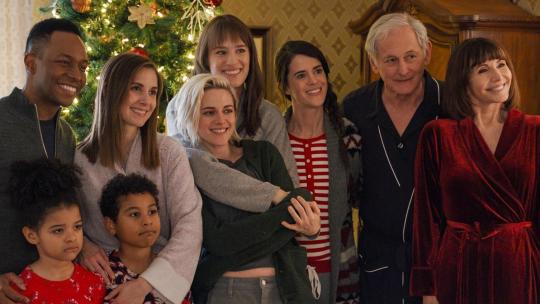
Yet, Stewart and Davis maintain their hold on us and keep things from turning into a complete farce. Take the Harper character for instance: Davis actually makes us dislike her for a time as she becomes increasingly cold toward Abby yet miraculously wins us back as she, God forbid, lets us see things from a different perspective.
I’ve known about this film for some time as I’ve been following Davis’s career closely since her brilliant work as Cameron Howe in the severely overlooked Halt and Catch Fire. I assumed the movie was a drama based on the plot summary. I think there’s a great film to be made still by taking a serious approach more suitable for this material. Then again, maybe a mainstream audience not inclined to seek out such fair would miss out on the important messages within. That truly would be a shame.
8 notes
·
View notes
Text
The New Mutants: *** out of 5

Has there ever been a movie as destined to fail as The New Mutants? The latest superhero film from 20th Century Fox is based on an X-Men comic book spin-off launched in 1983, not well known by the general public. Even if ‘X-Men’ were added to the film title, it still would be associated with a dwindling movie franchise whose assets have just been absorbed by Disney. The film’s suffered from a lackluster marketing campaign and poor reviews, and oh, we’re also in the midst of a pandemic; folks aren’t exactly rushing to theaters and if they do muster the courage, they’re surely seeing Tenet or the third Bill and Ted adventure.
True, it’s hard to shed many tears over the misfortune of a big studio production or pretend it’s some sort of game-changer…but, it’s actually not terrible. That is to say, considering everything going on in the world right now, it’ll do.
Don’t expect to see any A-listers that you’ve come to know and love like Wolverine, Storm or Professor X. Here, we’re introduced to an entirely new batch of young mutants navigating puberty along with the angst and superpowers that accompany that crucial life stage. You won’t find the typical Marvel template here either, at least with respect to tone. Instead of a light action-adventure with heroes battling villains for the fate of the world, writer-director Josh Boone and co-writer Knate Lee have gambled on a horror story set in a confined space where our heroes battle (mostly) internal demons.
Danielle ‘Dani’ Moonstar (Blu Hunt) acts as our surrogate for this pocket of the Marvel Universe. We’re introduced to the young Cheyenne Native American as she flees the destruction of her reservation to find shelter during a tornado. After being knocked unconscious, she awakens in an eerie hospital run by Dr. Cecilia Reyes (Alice Braga, an odd choice for an even odder character adaptation) who informs Dani that she’s a mutant and suggests she stay put until she discovers and controls her power. The doctor also introduces her to the other young mutants who have been brought to the hospital with similar baggage.

This all sound familiar? I did say it was an X-Men spin-off; the patients even think they’re being trained as the next generation of the iconic team. Well, they’re not and although Dr. Reyes tells them they’re to remain in the facility for the protection of themselves and others, she may be omitting some important details. That’s where the narrative diverges from the typical X-Men film. So, besides the appeal of a superhero tale mixed with horror elements, the other major selling point is the idea of a group of impressionable young mutants being discovered by actors much less benevolent than the great Charles Xavier.
The filmmakers are on to something here, but the short 94-minute run time and all-but-certain interference from studio execs don’t leave the artists much room to juggle a horror film, superhero film and coming-of-age story all at once. There are moments throughout when the various genre elements do work—alone or in conjunction—but they never coalesce into something that transcends their potential. It’s not scary enough, the action is sparce and the character arcs are unremarkable. It’s a shame; the X-Men franchise has always worked as an allegory for the anxieties and struggles that accompany puberty and the additional horror element could’ve really amplified this idea had the film dared to dig deeper.
It’s not as if the movie’s devoid of interesting characters with which to explore these issues. In fact, the core mutants and their interactions arguably are more compelling than those in the original X-Men from 2000, where some iconic superheroes like Cyclops and Storm felt like afterthoughts.

That said, the quality of character and performance on display is still inconsistent. Maisie Williams gives the best performance as the earnest Rahne Sinclair whose power of lycanthropy is at odds with her religion. This kind soul quickly befriends the alienated Dani. Anya Taylor-Joy and Charlie Heaton are fine as Illyana Rasputin and Sam Guthrie; the former can summon magical swords, armour and portals while the latter blasts through the air like a cannonball, becoming invulnerable mid-flight. They’re skilled actors but lay it on a bit thick with her Russian accent and his southern drawl; though, you have to respect Taylor-Joy’s charisma and her amusingly hostile attitude toward Dani. Henry Zaga plays Roberto da Costa, the typical cocky playboy who can manipulate solar energy. He has his moments.
Unfortunately, Hunt gives the weakest performance as Dani whose powers are as hard to pin down here as they are in the comics (something about creating illusions based on emotions). She’s the one with whom you’re supposed to empathise the most, but it’s challenging when the pain and vulnerability on display rarely feel authentic.

Kudos to the production team, though, for following the lead of comic book icon Chris Claremont and including several females and people of colour in the film while adding a same-sex relationship. Kudos to them, as well, for staying faithful to the mutants’ cool powers from the comics despite them being exhibited so sparingly. It would’ve been nice to see Sam blasting around a bit more or Rahne in full ‘beast mode’. This goes for the action in general. It’s refreshing to see a superhero film that doesn’t bombard our senses for 2.5 hours, but in The New Mutants, the pendulum swings too far the other way. The final battle practically ends before it begins, but at least a certain purple creature makes a most welcome appearance.
It’s hard being too critical toward a comic book film with a relatively small budget whose creators really tried to do something different. You almost feel bad that it’ll be lost amidst Disney’s acquisition of Fox and their incorporation of the X-Men properties into the Marvel Cinematic Universe. Honestly, the restructure is for the best; the famously inconsistent franchise could use the MCU makeover. And, yet, when the credits started rolling and I realized I might not see these five individuals again, imperfections and all…I felt a little bummed out. That’s gotta count for something, right?
4 notes
·
View notes
Text
The King of Staten Island: ***1/2 out of 5
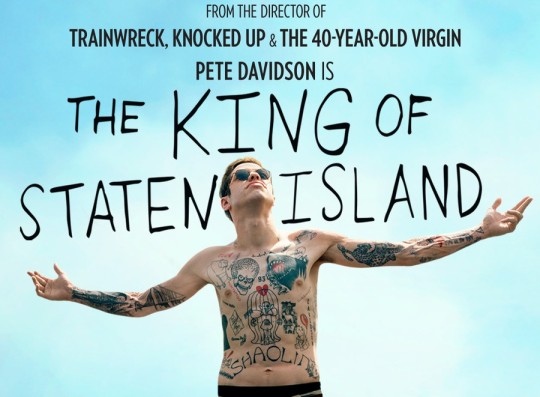
In an episode of Game of Thrones, Tyrion Lannister, a dwarf shunned by his own family, admits he has “a tender spot in [his] heart for cripples and bastards and broken things.” So, it’s fitting that he shows up in Judd Apatow’s new film The King of Staten Island as two characters are watching the HBO masterpiece. Throughout his career, the writer/director/producer has shown an obvious soft spot for the underdog, except he’s focused his attention on slackers and stoners and virgins, but you get the idea. One of hist first projects was even called Freaks and Geeks.
Pete Davidson of Saturday Night Live fame plays Scott Carlin, Apatow’s latest burnout to embark on a grueling emotional journey toward some sort of purpose. As the film opens, he seems quite content with simply smoking weed with his equally aimless friends; having sex with Kelsey (an explosive Bel Powley) without the burden of commitment; mooching off his widowed mother, Margie (Marisa Tomei, marvelous as always); and avoiding an honest day’s work like the plague. A 24-year-old high school dropout, Scott lives with his mother and sister, Claire (Maude Apatow), on Staten Island, one of the five boroughs of New York City that’s just as much a joke to other New Yorkers as Scott is to society at large.
It’s the perfect setting for a movie whose protagonist uses his regrettable circumstances as an excuse to remain in a perpetual state of arrested development. It’s no cesspool, but it’s hard to imagine the residents of this drab, nondescript sub-city truly thriving. Scott also suffers from several illnesses including Crohn’s disease and ADHD as well as the mental anguish of losing his father, a firefighter, in the line of duty when Scott was younger. He too easily lets these burdens weigh him down and impede his growth.

You don’t need a magnifying glass to notice the similarities between actor and character; it’s reasonable to describe the story as semi-biographical. Davidson doesn’t shy away from divulging details of his private life to the public, even discussing his mental health on SNL’s Weekend Update from time to time. His body is also riddled with tattoos, he’s no stranger to the reefer, he grew up on Staten Island and his father was a firefighter who died when Davidson was younger, only it was during the 9/11 attacks. The major difference is that Davidson’s battled adversity to become a successful comedian and one of the youngest SNL cast members of all time. Scott, on the other hand, has an interest in tattoo artistry, but he’s not very good and neither is his idea of a tattoo parlour/restaurant business, details that lead to a handful of amusing arguments about art and sanitation.
Practising his hobby on a nine-year-old boy is also a bad idea as he learns when the boy’s father, Ray (Bill Burr in an impressive dramatic turn), shows up on his doorstep, launching a hilarious tirade at Scott right in front of his mother. With that in mind, Scott’s understandably aghast when he learns Margie and Ray have started dating which is exacerbated by the fact that the first guy she’s dated in 16 years happens to be a firefighter like her late husband. This is the necessary spark that leads Scott down a path of something he dreads: change.
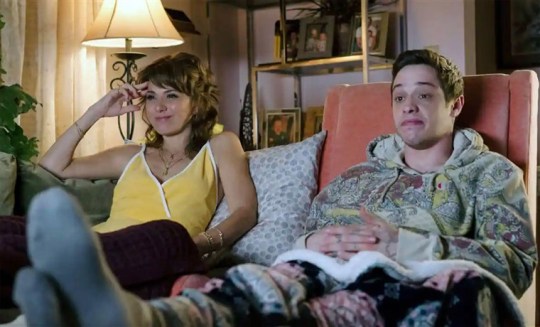
There’s not much here that Apatow hasn’t already tackled. He’s quite comfortable in his wheelhouse of slacker dramedies. But what the film lacks in originality, it makes up for in delightful performances, complex characters and Apatow’s signature blend of irreverence and poignancy with a surprising emphasis on the latter. He struck gold with the three leads; okay, Tomei’s predictably sublime, but comedians Davidson and Burr, though still their zany selves, strike disarmingly serious notes throughout the movie, giving us a clear view of their dramatic potential. The chemistry among these three—a mixture of jealousy, anxiety and resentment with hints of sympathy—is what gives the film its deeper meaning.
Sure, you can argue Davidson is just playing a version of himself. How hard could that be? He’s been doing it for six seasons on SNL. No one seems to know what else to do with him. Nonetheless, this movie needs him and maybe he needs this movie. It might be just the catharsis he requires, like his counterpart, to evolve emotionally and professionally.
The movie also benefits from an equally talented supporting cast. Powley gives a breakthrough performance as Scott’s friend with benefits. Kelsey’s a tiny girl with a ferocious personality, yet Powley still makes it easy to empathize with this girl who yearns for a better future and a bigger commitment from Scott. The wonderful Pamela Adlon from TV’s Louie and Better Things has a small but effective role as Ray’s ex-wife Gina whose tired face tells us that marriage put her through the wringer. In an amusing scene, Scott has drinks with Gina to get dirt on Ray, something she’s more than willing to divulge. And, of course, the one and only Steve Buscemi turns up as a veteran firefighter who sees Scott as a lost soul that needs some guidance and support instead of a lost cause to be brushed aside. The exchanges between these two about Scott’s dad, fire fighting and life in general are truly touching.

At 136 minutes, The King of Staten Island is long for a comedy. Yet, it doesn’t feel long, as is common with Apatow’s films. His stories are more than just thin plots glued together with a quota of gags. He knows that if we’re going to care about his characters and be willing to follow their struggle for more than two hours then he needs to invest time and effort in them as well. Thankfully, he’s good at that and the film never wears out its welcome. We could’ve done without the robbery sequence, though, which isn’t boring so much as out of place.
The same can’t be said about the cast. Each actor looks and sounds like they’re a product of New York City. I suppose that authenticity is easy to achieve when most of them actually are from The Big Apple. That’s not surprising; it’s a town brimming with fascinating people full of potential. And Scott Carlin is no exception.
5 notes
·
View notes
Text
The Hunt: **1/2 out of 5
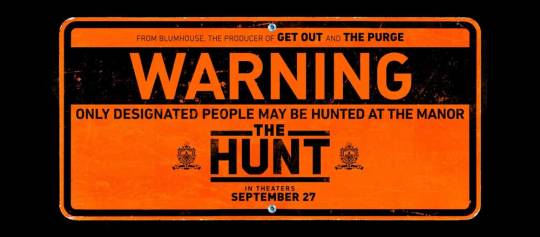
You can argue all you want about the quality of The Hunt or the controversy surrounding the film or even its link to Donald Trump, but there’s no denying the number of roadblocks this project has encountered on its mission to attract some sort of audience.
The new(ish) movie, directed by Craig Zobel, had an initial release date of September 27, 2019 before moving to October 18 then back to September 27 before being shelved indefinitely. The changes were made in response to the Dayton and El Paso shootings as well as Trump’s tweet criticizing liberal Hollywood for releasing violent movies and calling themselves elite. After all that, the film got a new release date of March 13th, but would you believe, it couldn’t be shown in theaters because they all closed due to some virus. Its final destination is on streaming platforms where it arrived just days after its theatrical premier. In short, the film’s been royally screwed. I guess that’s what you get when you don’t follow that old adage: ‘Always prepare for Tweets from a deranged president, two mass shootings and a pandemic.’
If Trump actually watched the film before deriding it (unthinkable!), he would’ve learned that those liberal ‘elites’ are actually the villains (you don’t really go to a movie to cheer on the hunter). Characters on both the left and the right are presented in negative ways, but it’s those on the left who commit horrifying acts. That’s the irony of the situation. What’s apt is how Trump’s knee-jerk reaction exemplifies what the film condemns. So, then, was this reaction good for the movie by validating one of its core arguments? I’m going to stop there before this gets too confusing.

Because, really, the film’s not worth such a complex debate. It’s not exactly much ado about nothing, but it’s much ado about very little. It all starts with a group text involving a bunch of rich, liberal ‘elites’ celebrating the upcoming hunt of ‘deplorables’, a not so secret code word for those on the far right and a reference to a Hilary Clinton quote from the 2016 Presidential Election. Suddenly, we’re in a forest where a group of people wake up gagged with no clue where they are or how they got there. They find a mysterious crate in a clearing just begging to be opened which is, fortunately, full of weapons and keys to their gags. Unfortunately, no sooner do they free themselves and gear up than they become target practise for their unseen captors. And we’re off! It’s a game of ‘elite’ hunters vs ‘deplorable’ prey.
That seems straightforward, but there are some twists and turns amidst the all-out carnage; after all, it was written by Nick Cuse and Damon Lindelof. Even so, they’re few and far between the gratuitous violence and when there is a revelation of sorts, especially near the end, it underwhelms. That’s partly because we already know so much from the outset; the twists are essentially minor tweaks. The story may’ve worked better if Lindelof followed his Lost playbook and kept us in the dark completely at first before gradually peeling away the layers. And it might’ve worked better as a satire or social commentary if it were delivered by a different narrative vehicle. There’re some intriguing ideas floating around in the fog of war, but they’re clumsily deployed and may be lost on an audience showing up primarily for a battle royale.

A major player in said battle is Betty Gilpin’s Crystal and thank God for that. Some may recognize the emerging actress as Debbie Eagan from Netflix’s GLOW and just as that character is wildly different from her wrestling alter ego Liberty Belle, so too is Crystal, who’s not so much America’s Sweetheart as America’s One-Woman-Army. She has the combat skills and tactical awareness of a soldier and she’s one of the few players in this scenario that gives the hunters a significant challenge. Crystal’s a deadly woman of few words and a lethal scowl—one Gilpin employs a tad excessively—but the actress makes her more complex than the standard cinematic female warrior and helps elevate this movie to a level of being watchable.
‘Complex’ isn’t a term I’d use for most of the other characters, though. For starters, there’s just not enough time to develop anyone amidst the gunfire and booby traps, especially when people are being picked off right, left and center in this hasty 90-minute story. And when the characters do speak, their dialogue is based almost entirely on stereotypes, as if the writers were checking them off from a laundry list before adding them to the script. One far-lefter takes offence over another far-lefter’s use of the word ‘guys’ to which the latter responds by saying, “I’m sorry. I gendered it.” One far-righter is asked why he owns seven guns to which he responds by saying, “Because it’s my constitutional right to protect myself if I should ever happen to be getting f***ing shot at.” Now, this movie can be categorized as comedy or satire, sure, but the exhaustive use of such lazy and obvious jokes becomes cringe-worthy, like watching amateur improv.
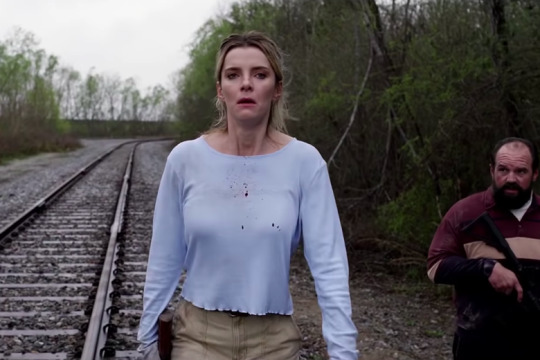
The movie does make some important points about the dangers of acting on bad information or what we call ‘fake news’ nowadays, but it takes its sweet time getting there then rushes to dispense the meat of the matter before serving us more filler. Yet, there’s still Gilpin. And, as with most of his work, Lindelof holds your attention throughout, even though, as with most of his work, you may or may not love where it leads. This movie should’ve never been delayed, shelved or censored in any way and I will always defend the right of an artist to release his or her work; however, that doesn’t mean I have to defend the work as great art. The Hunt is merely 90 minutes of passable entertainment. In our current situation, I suppose that’ll do.
2 notes
·
View notes